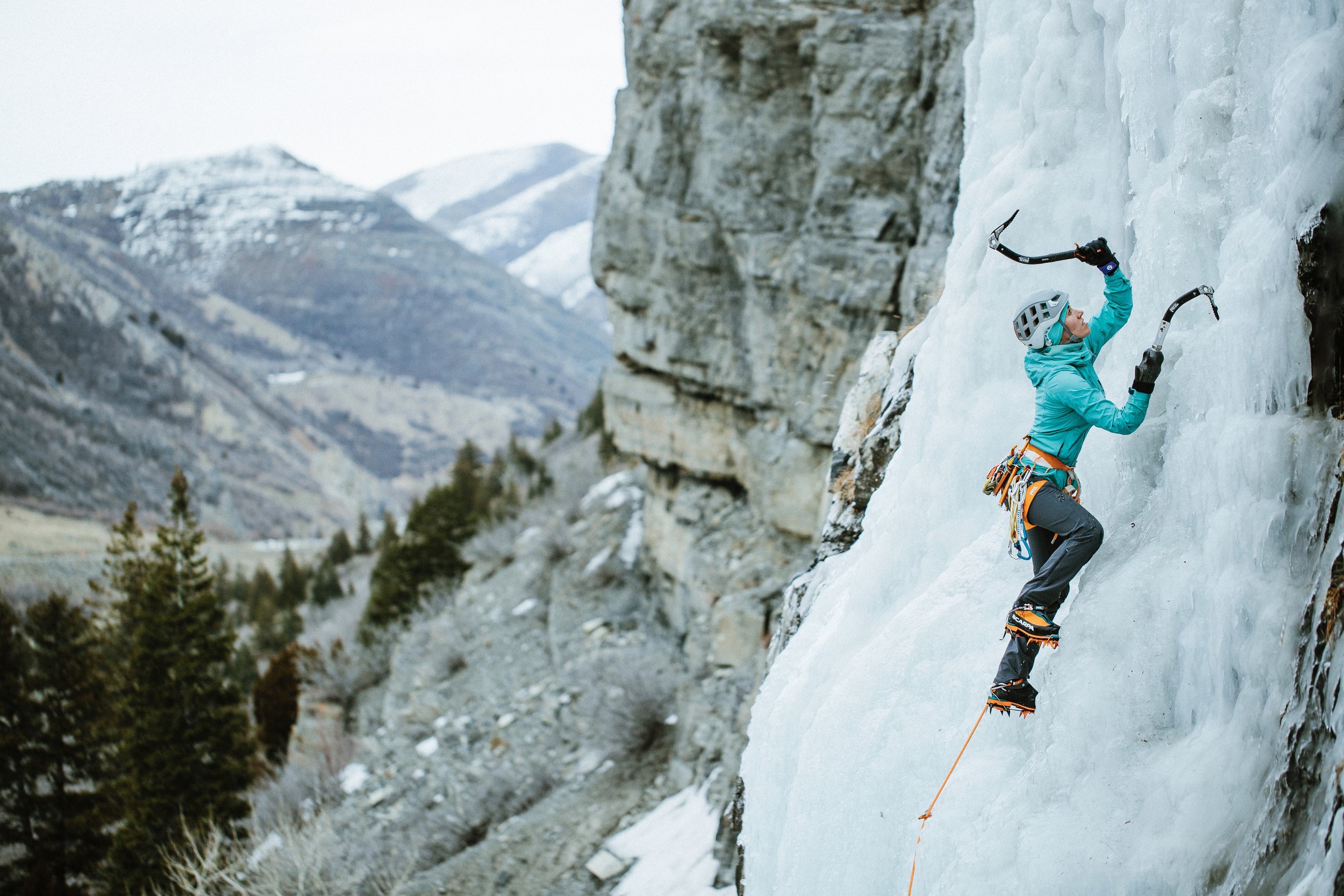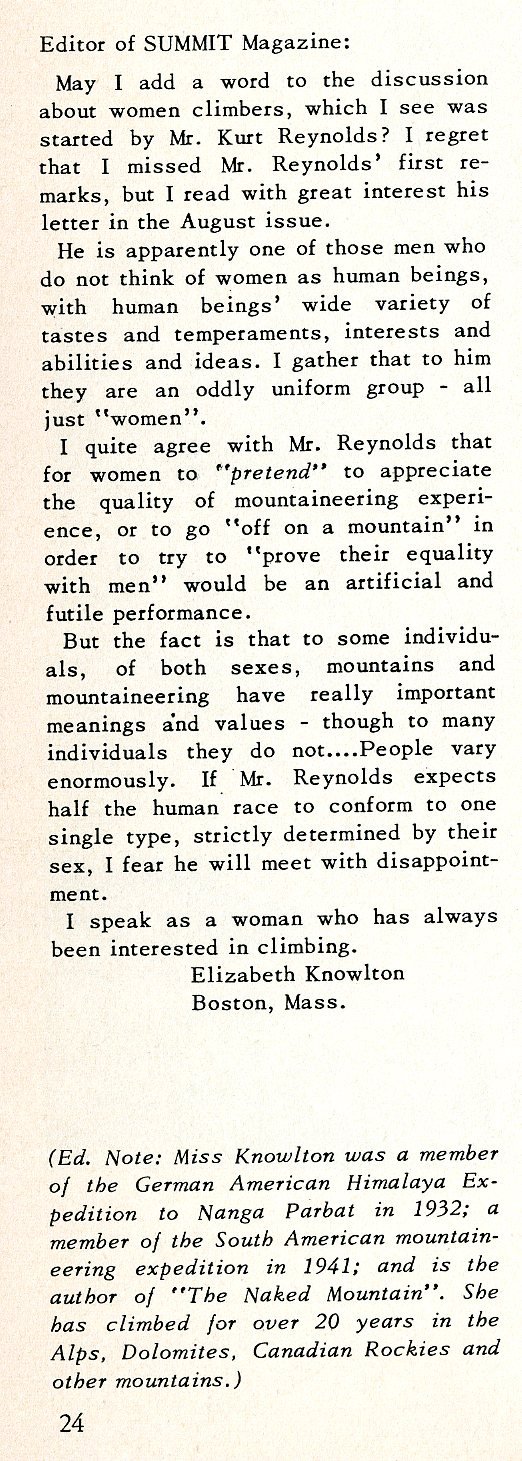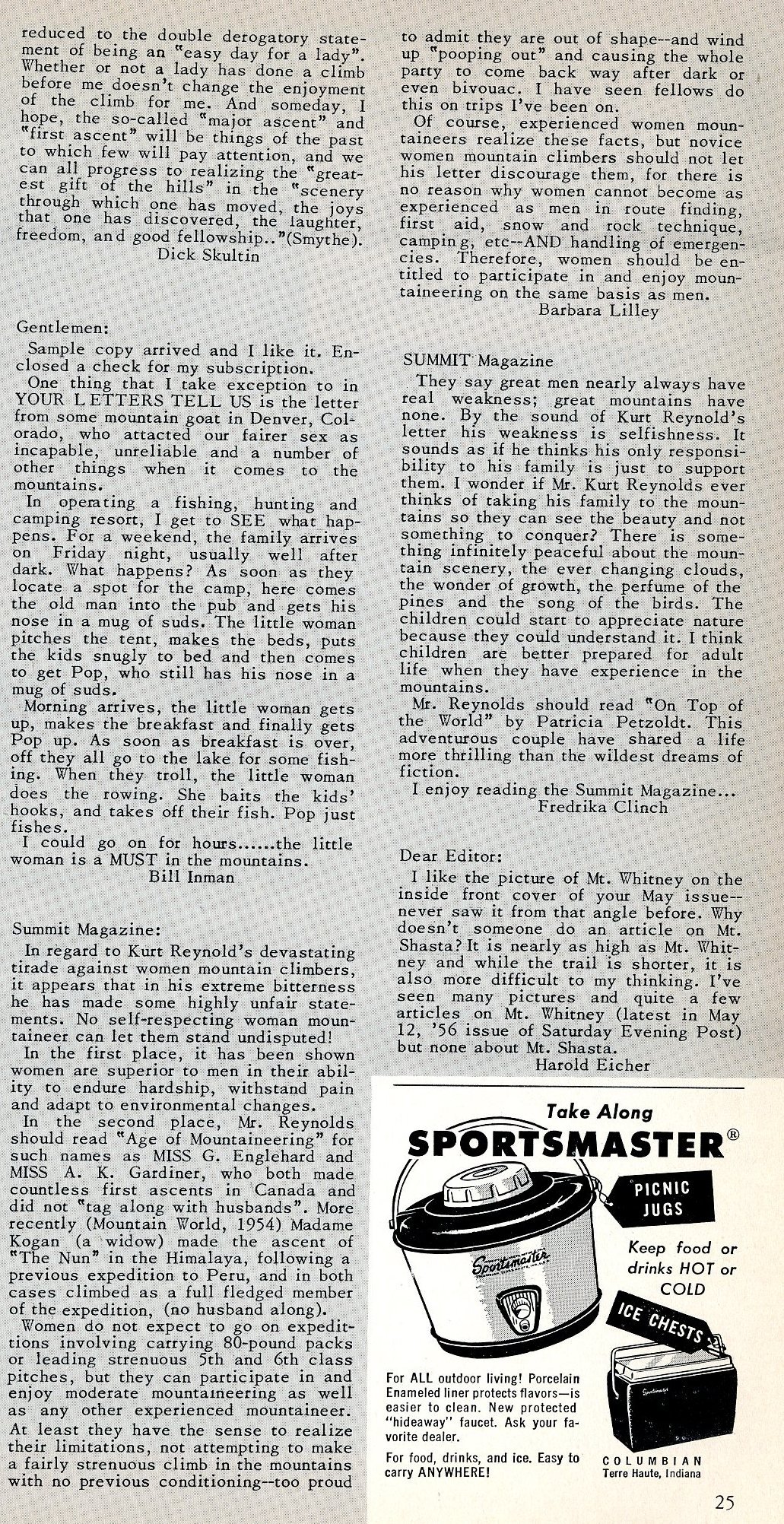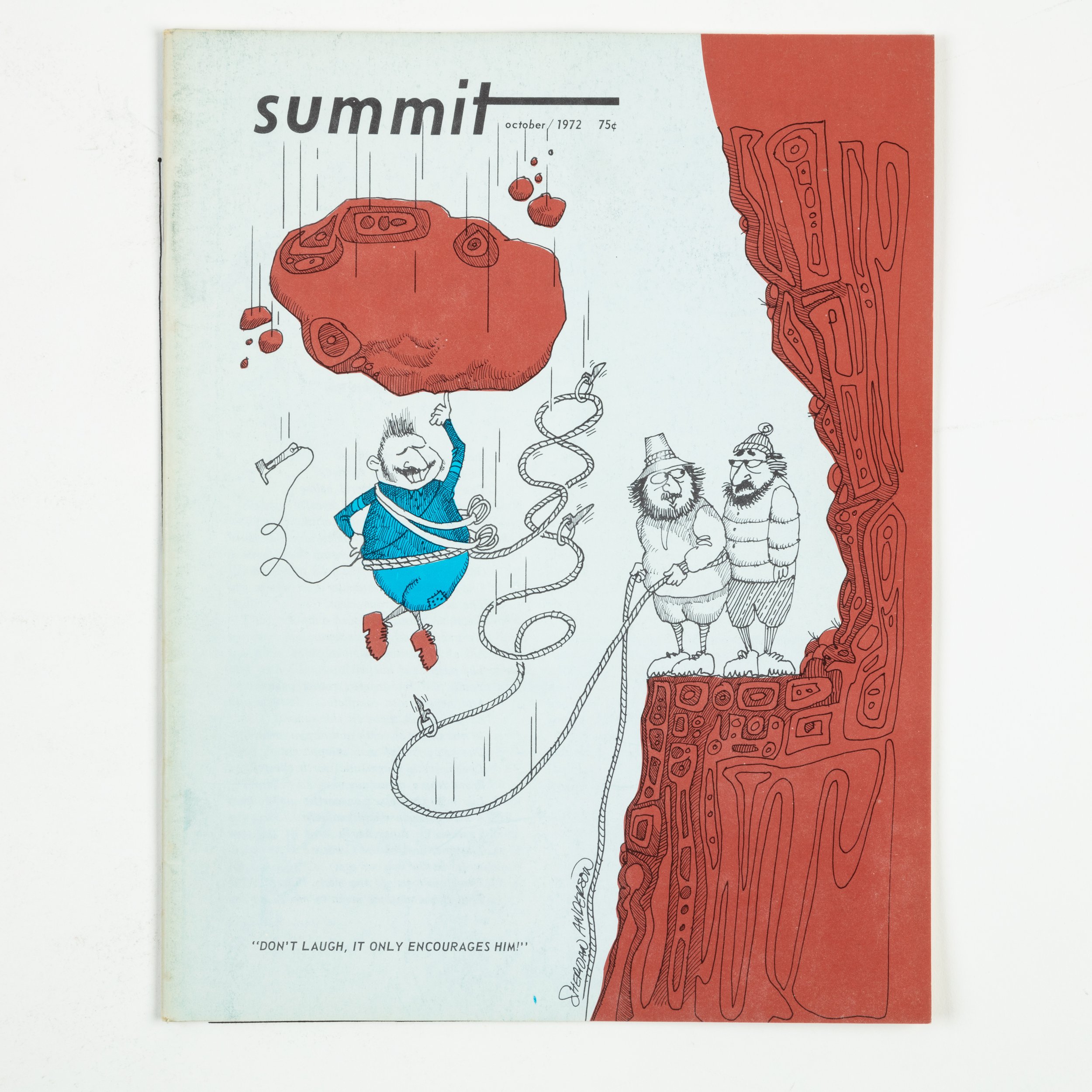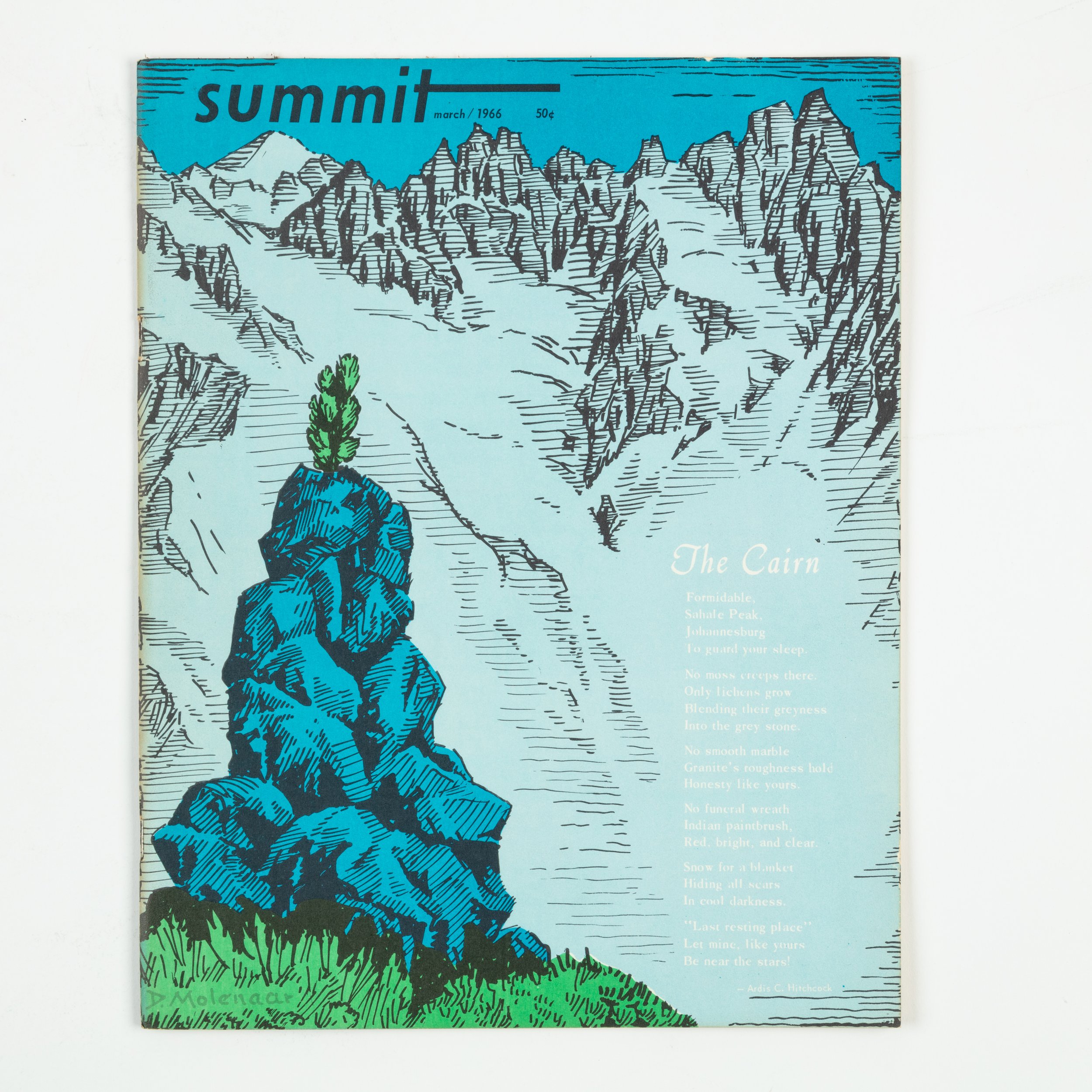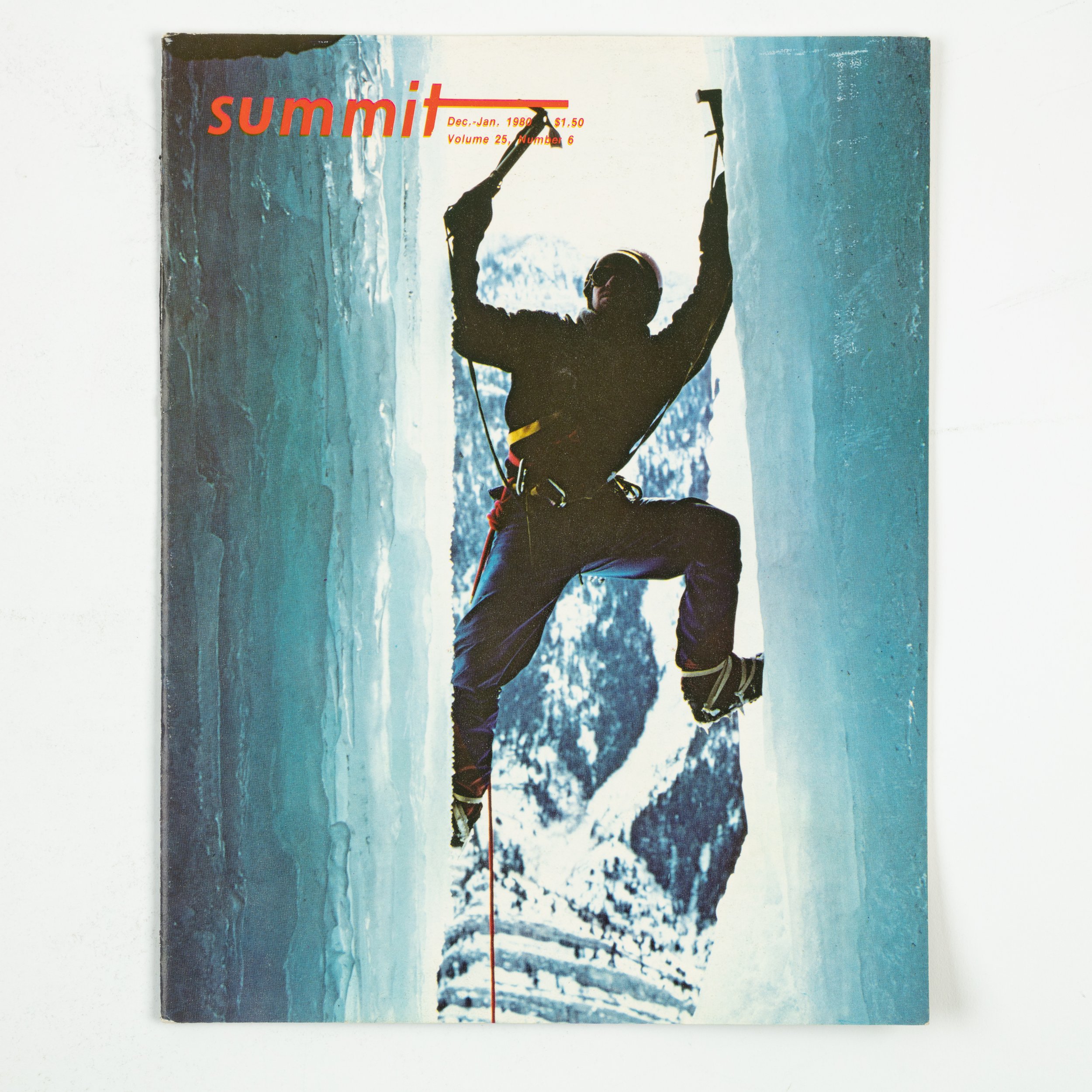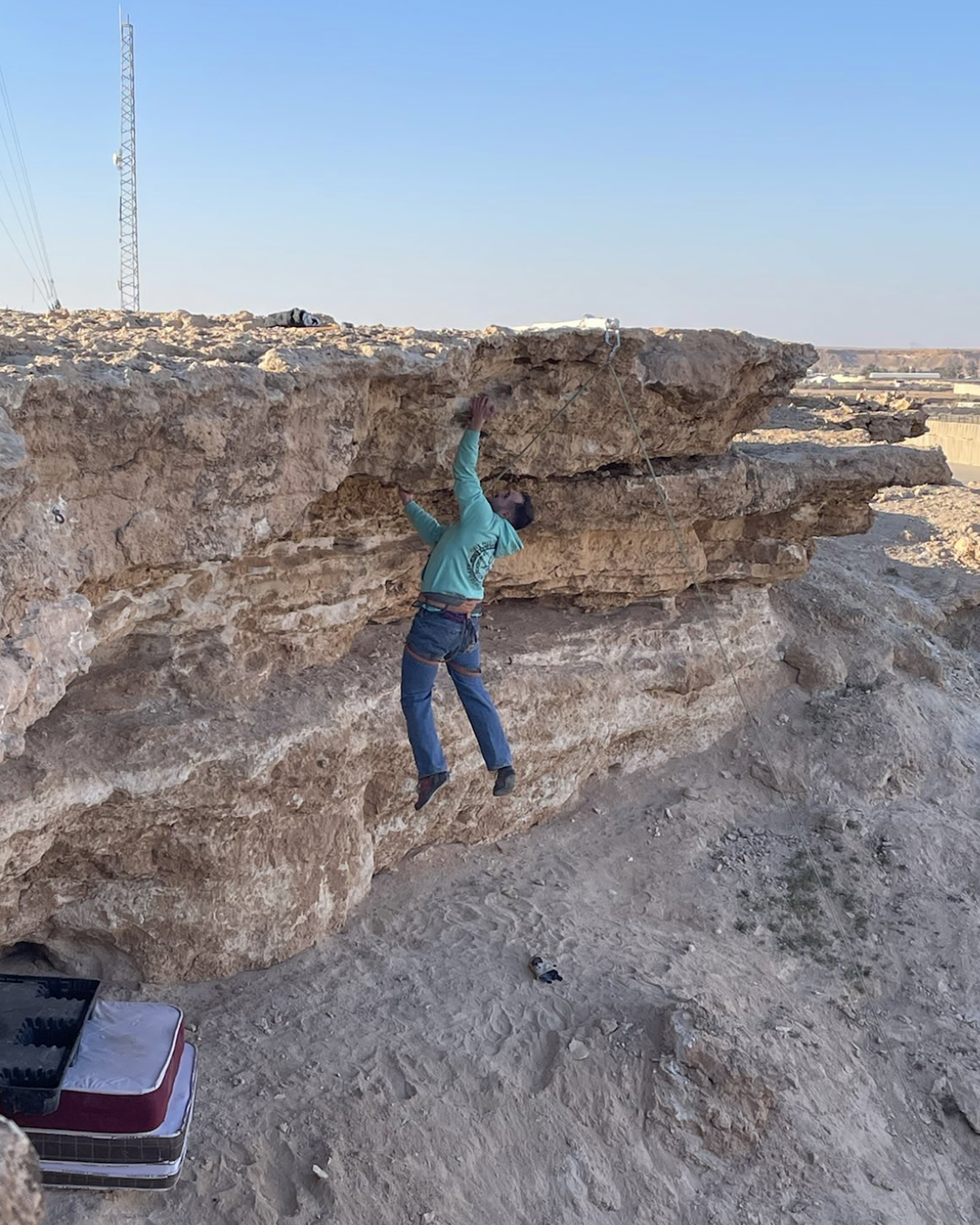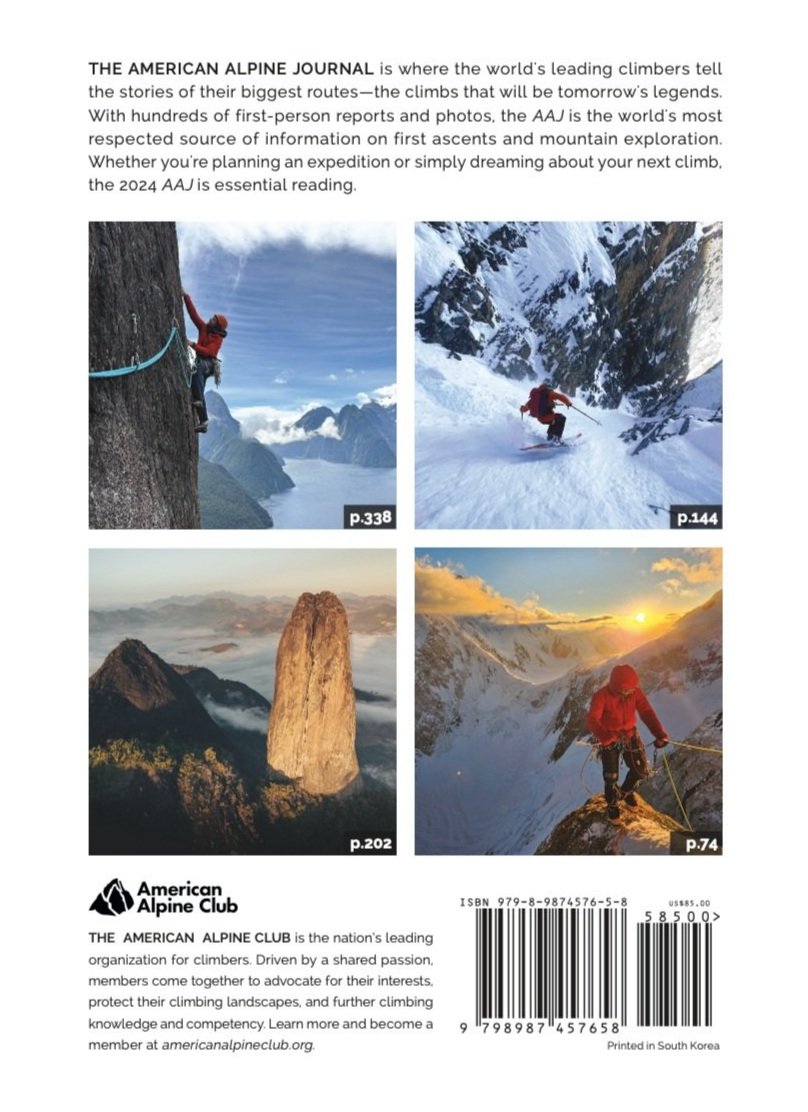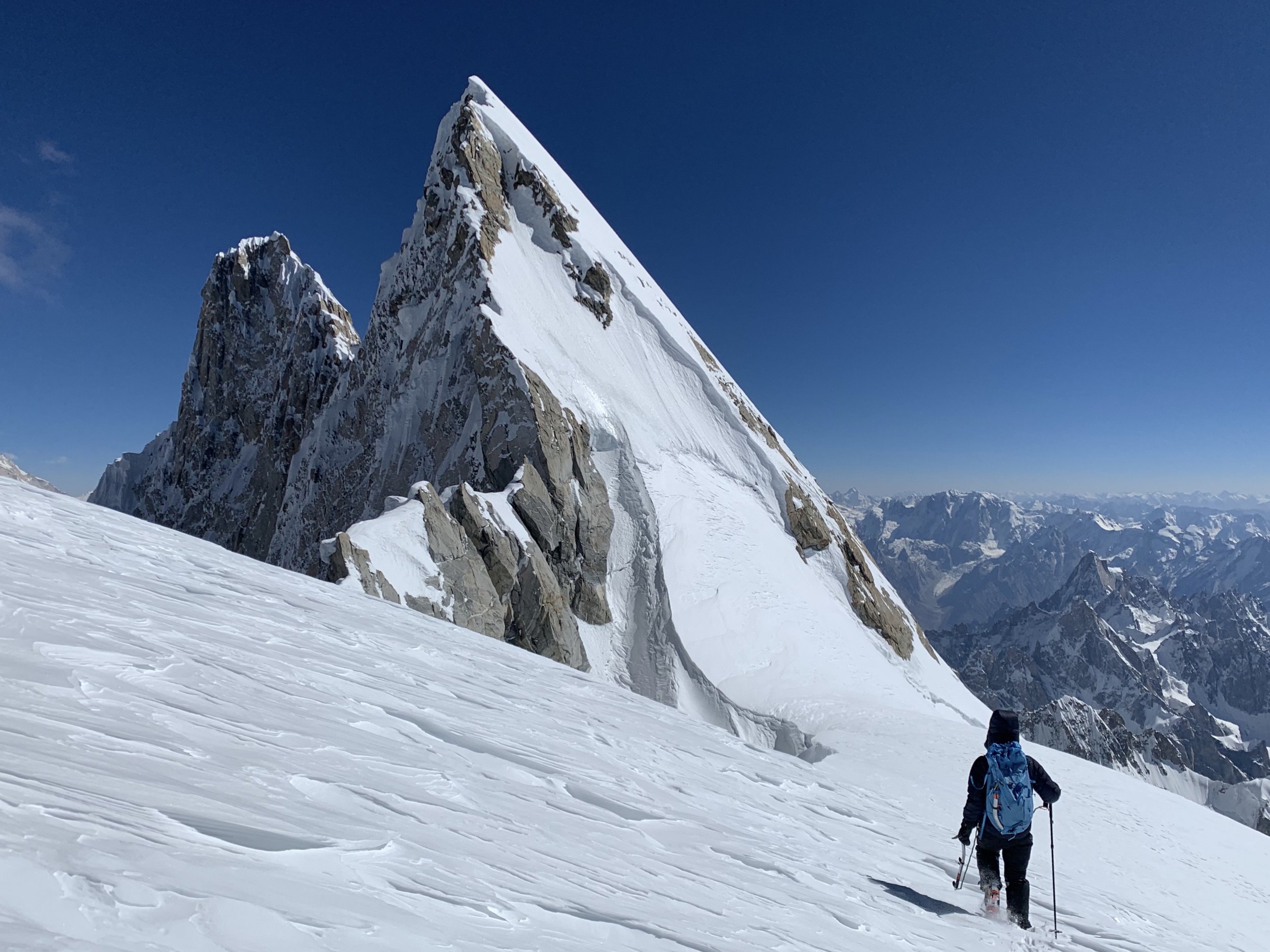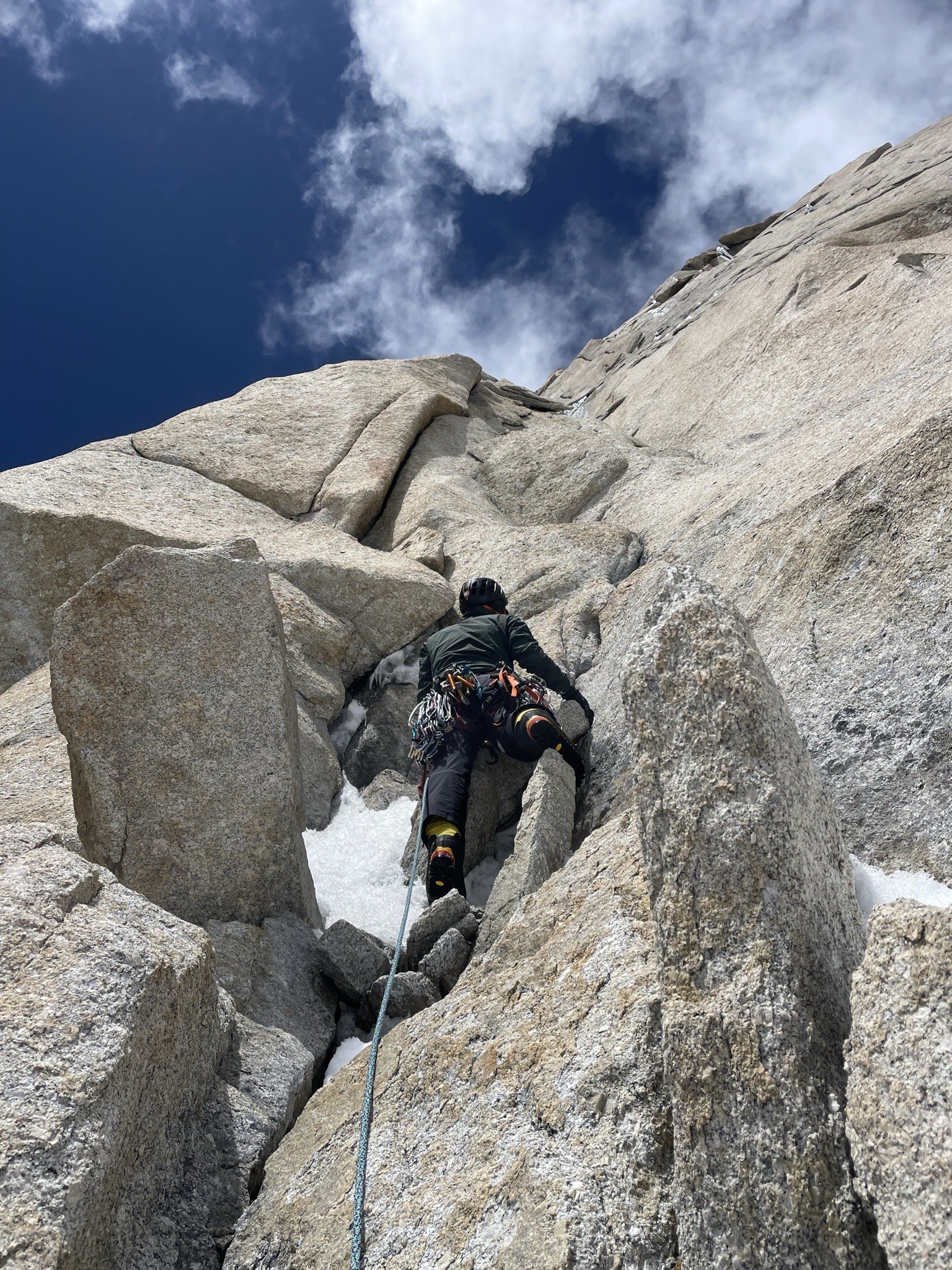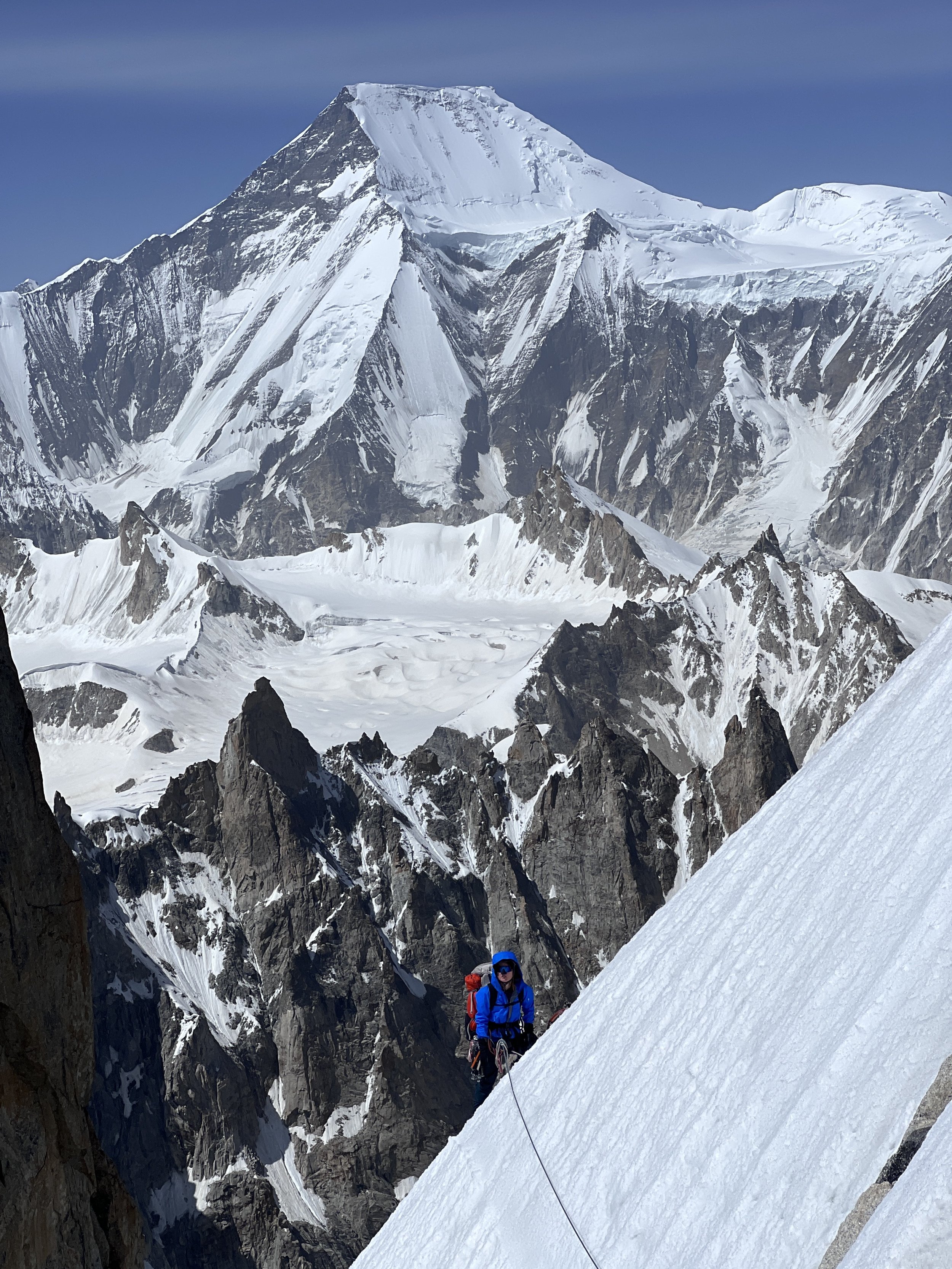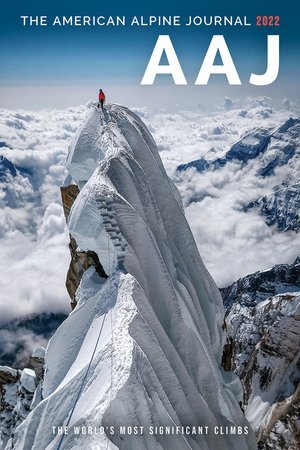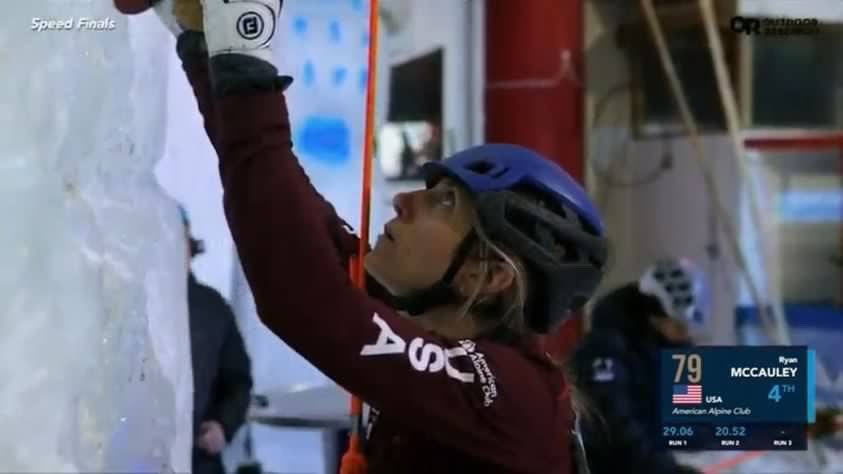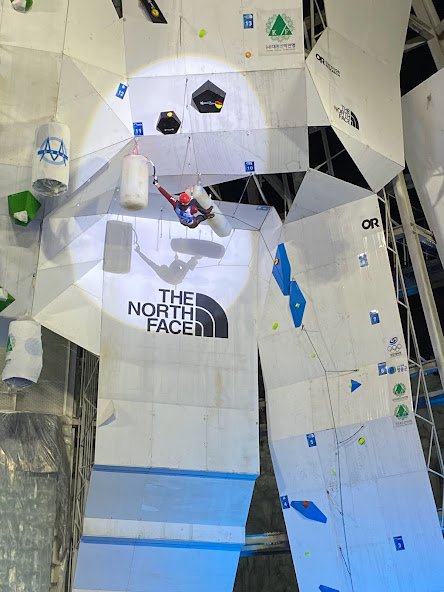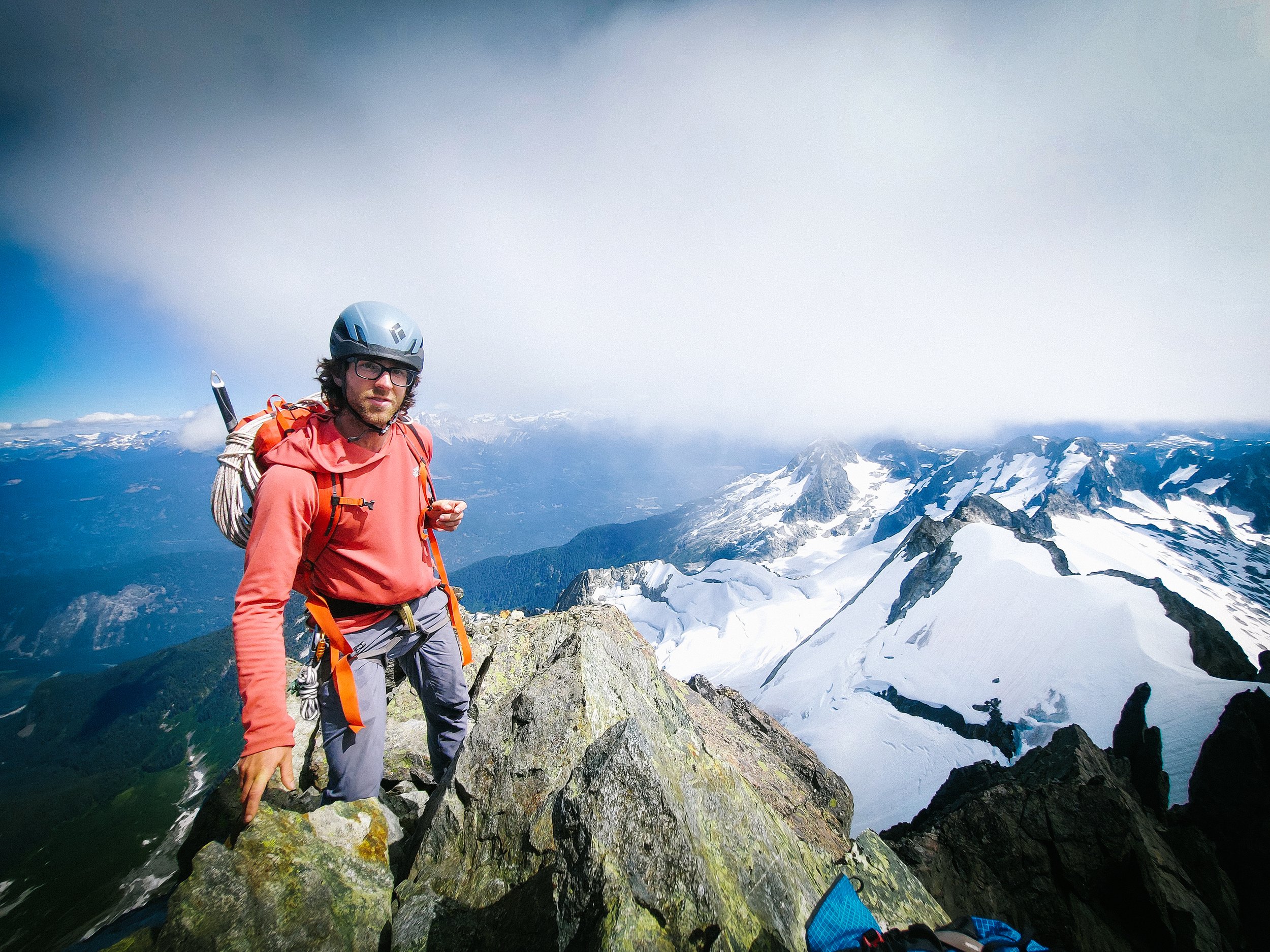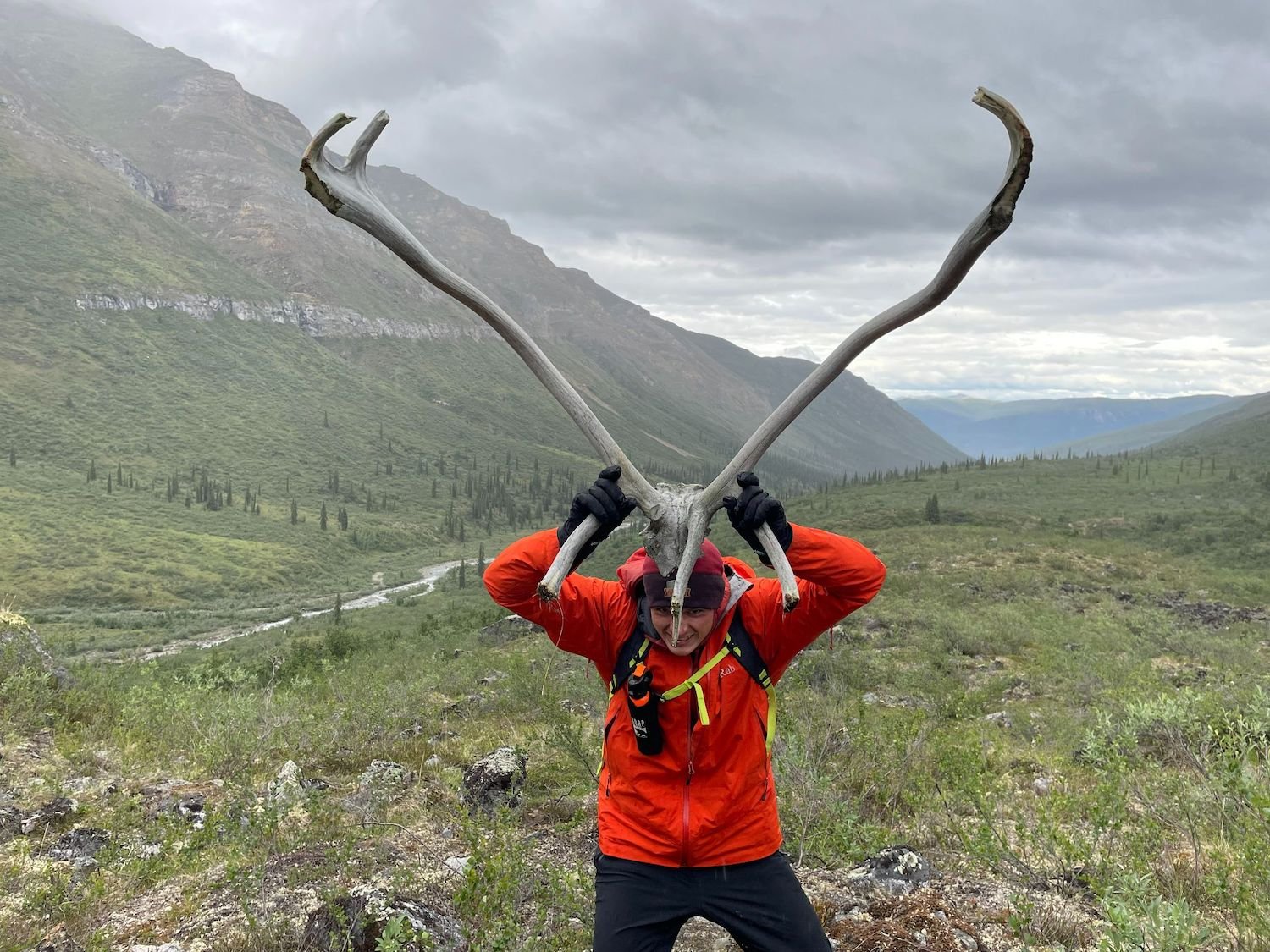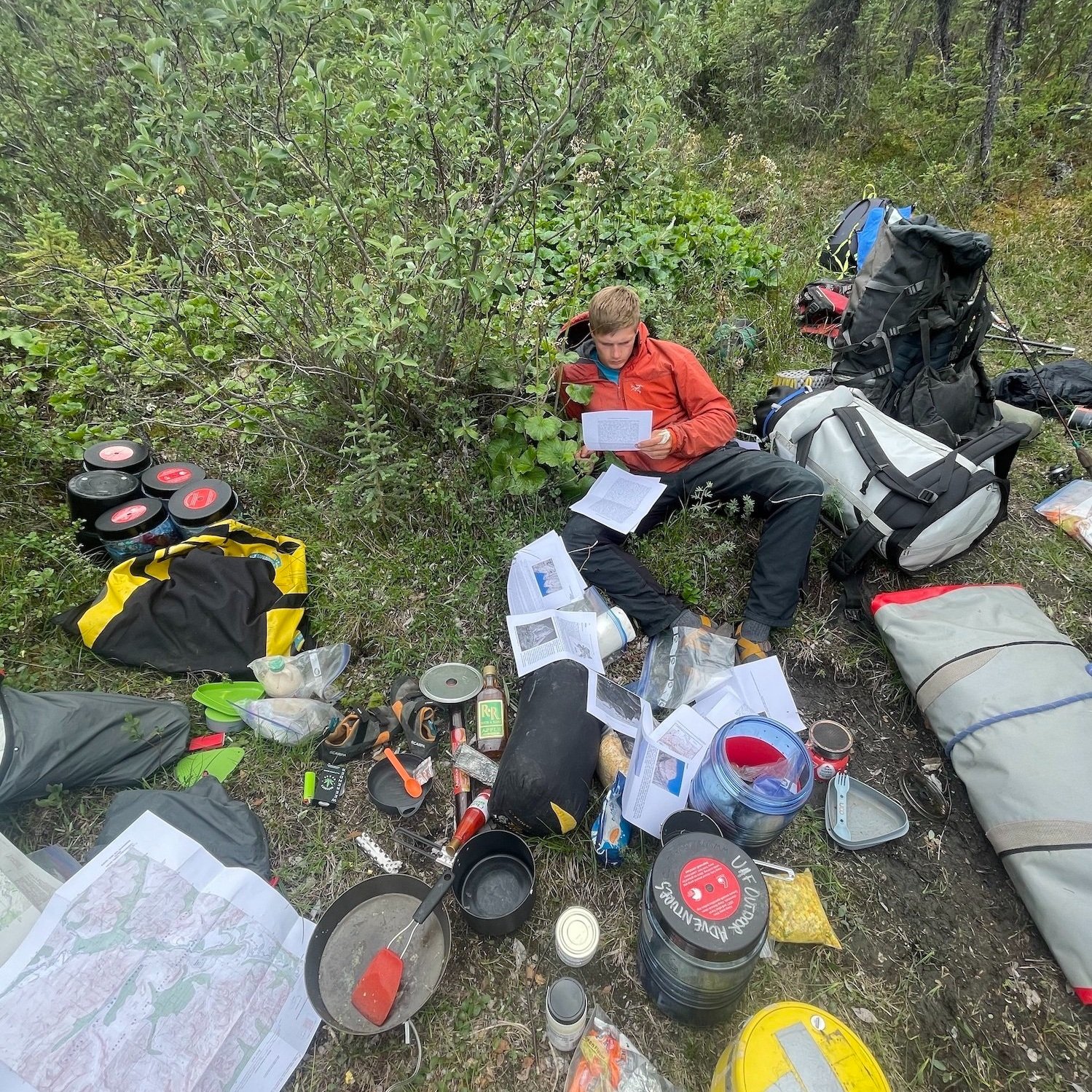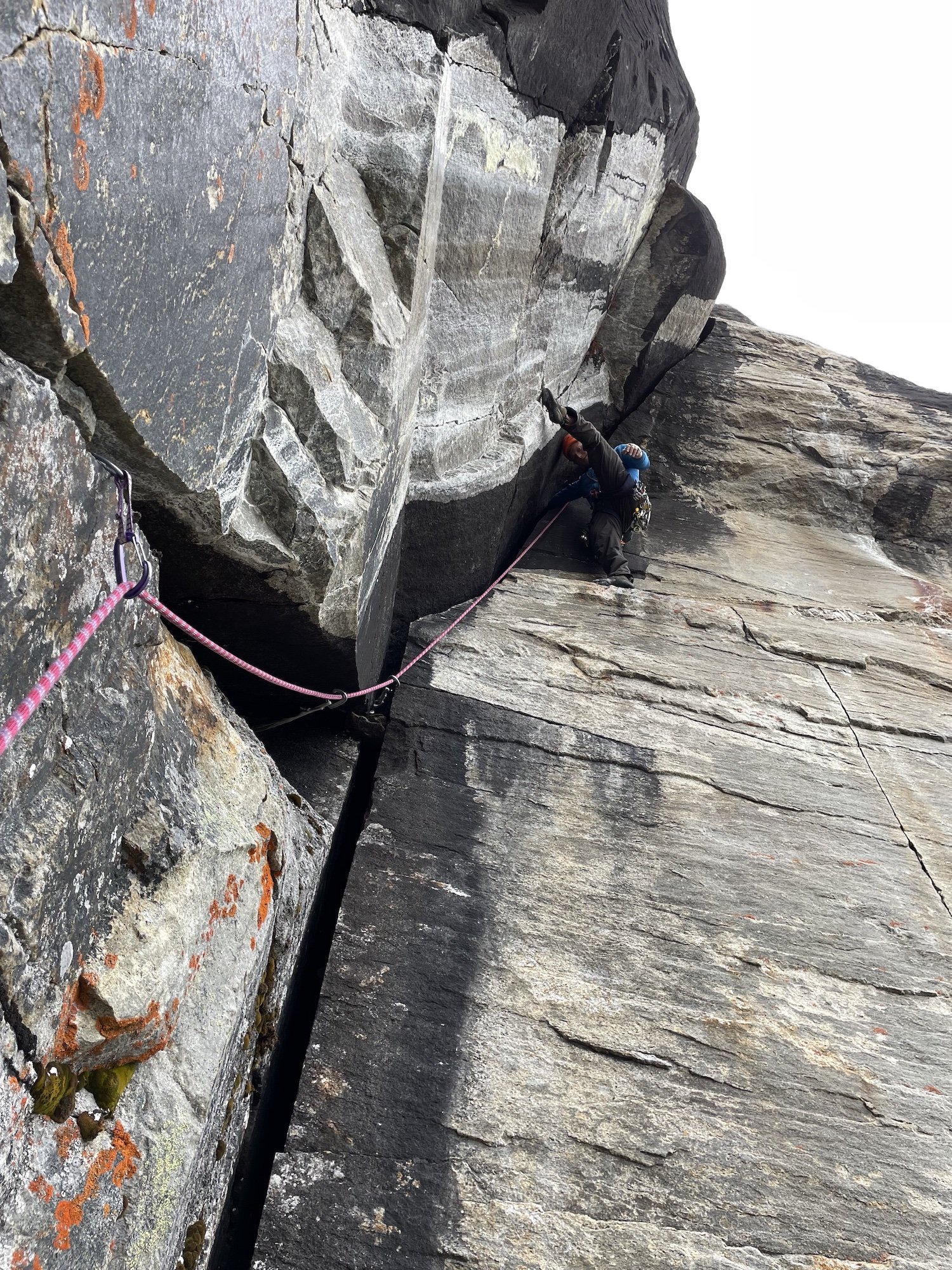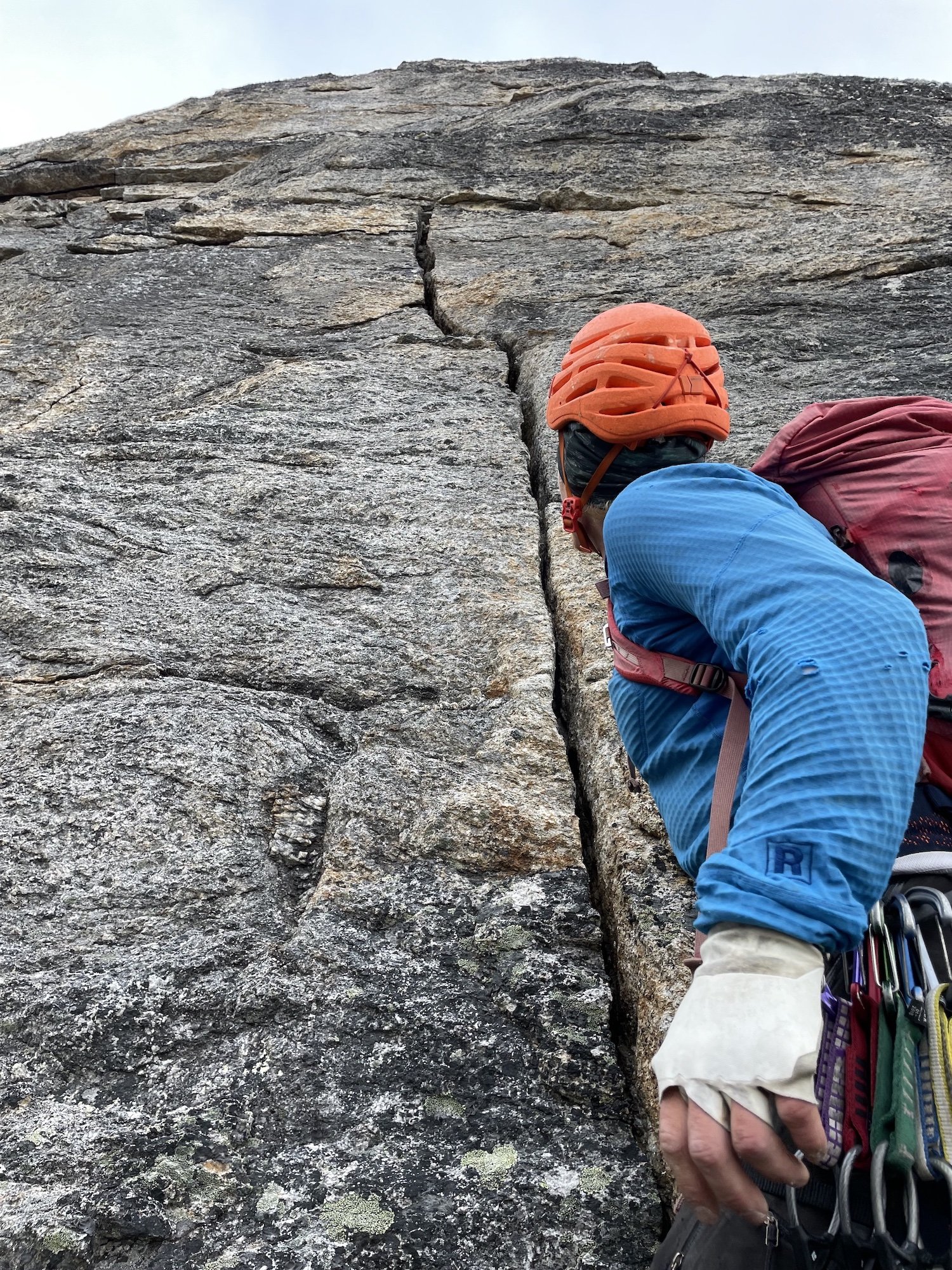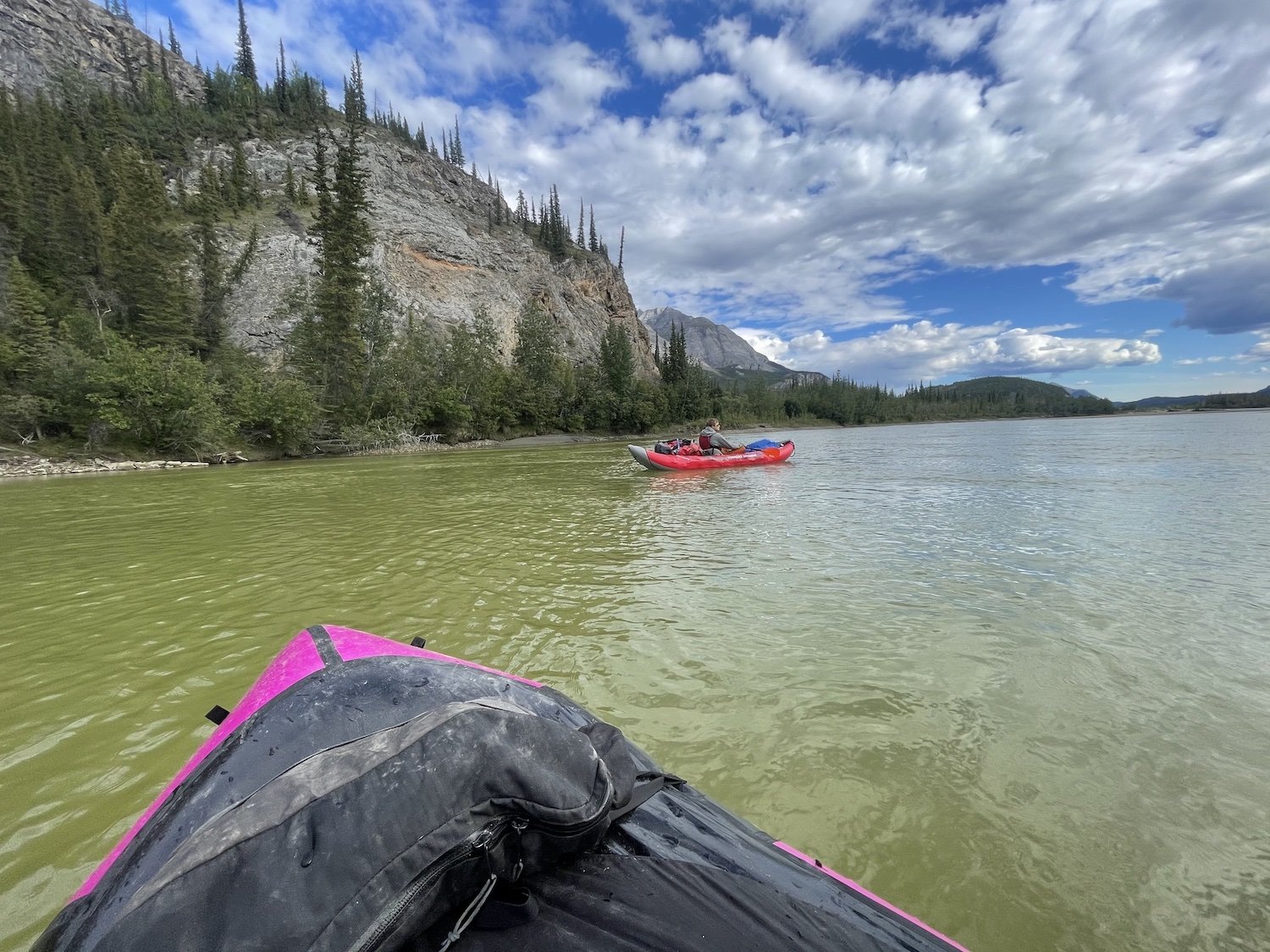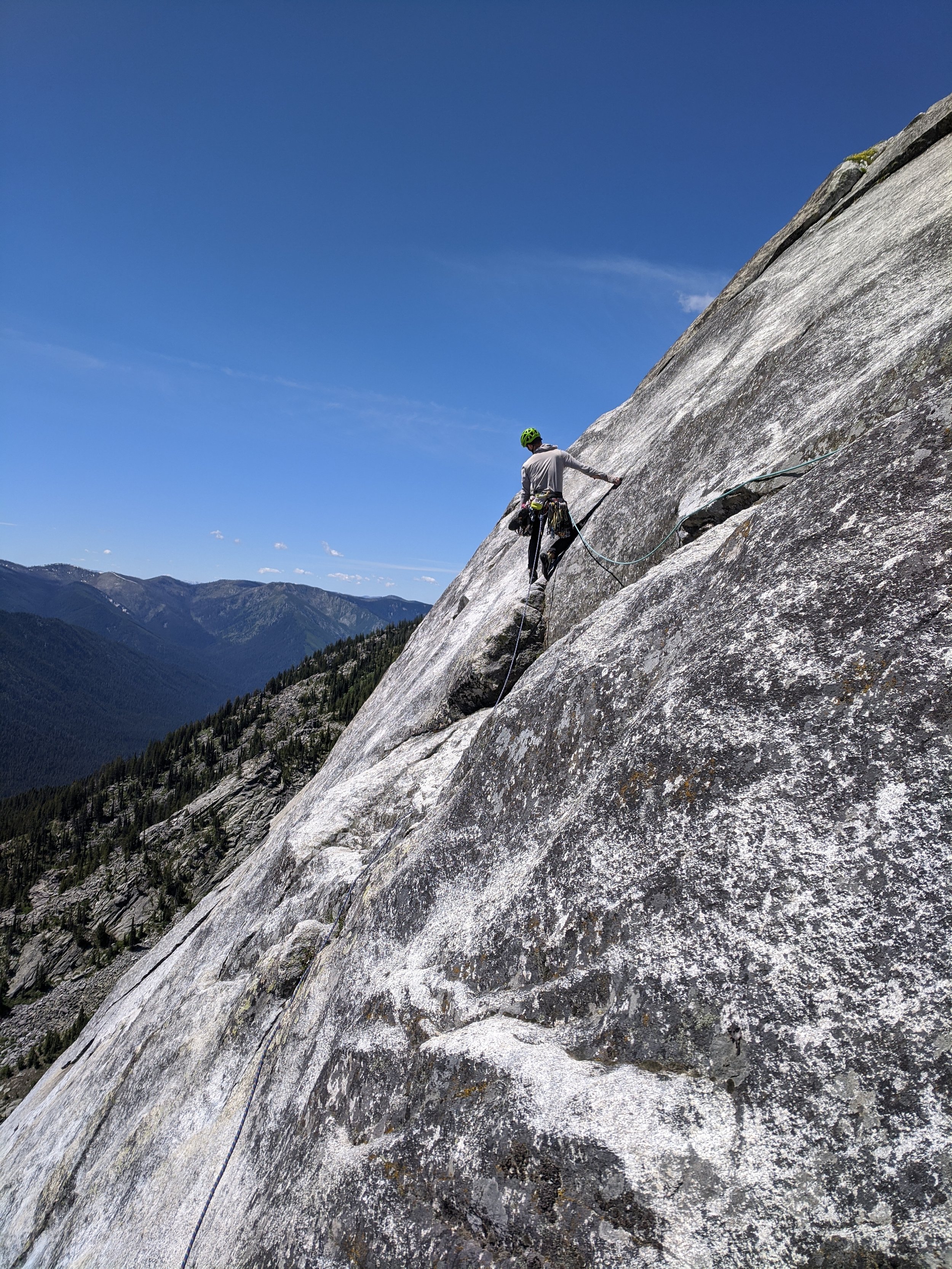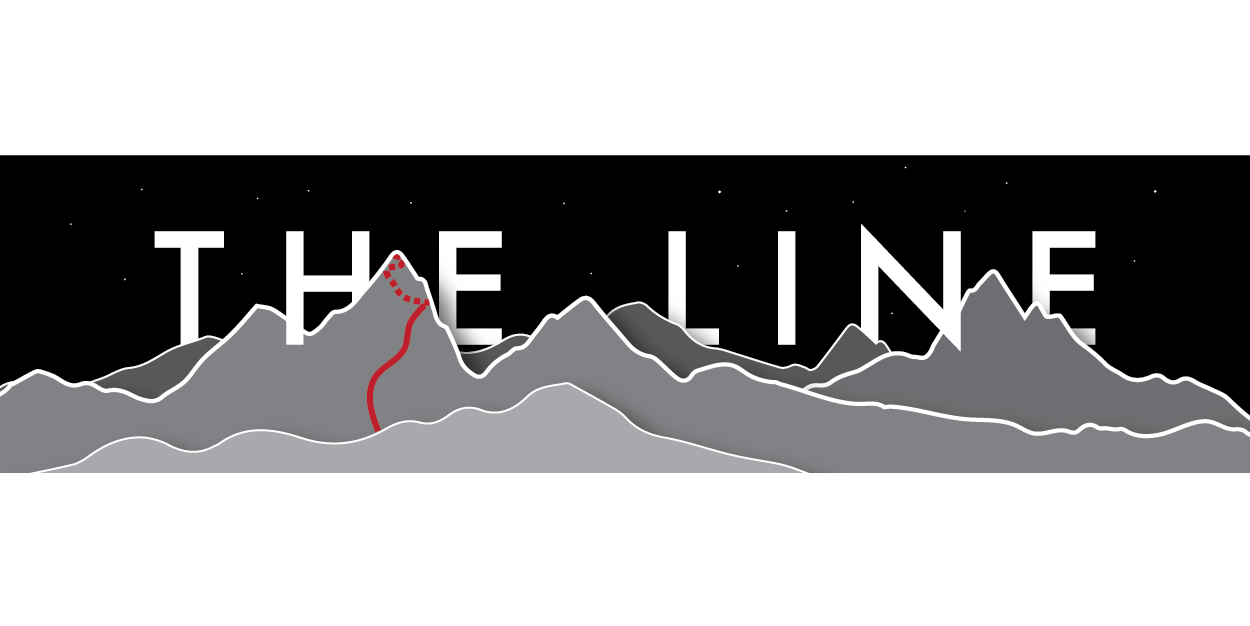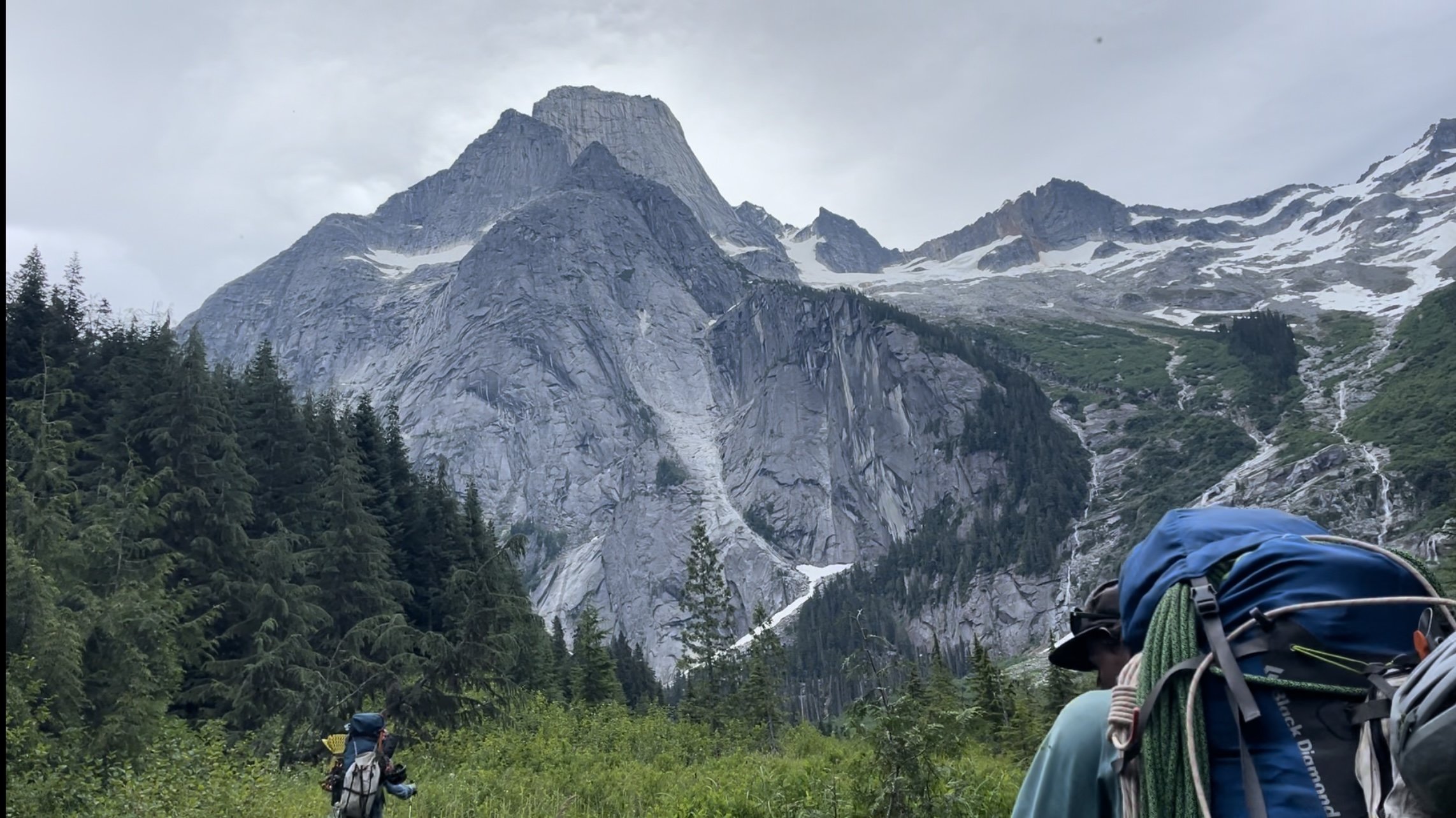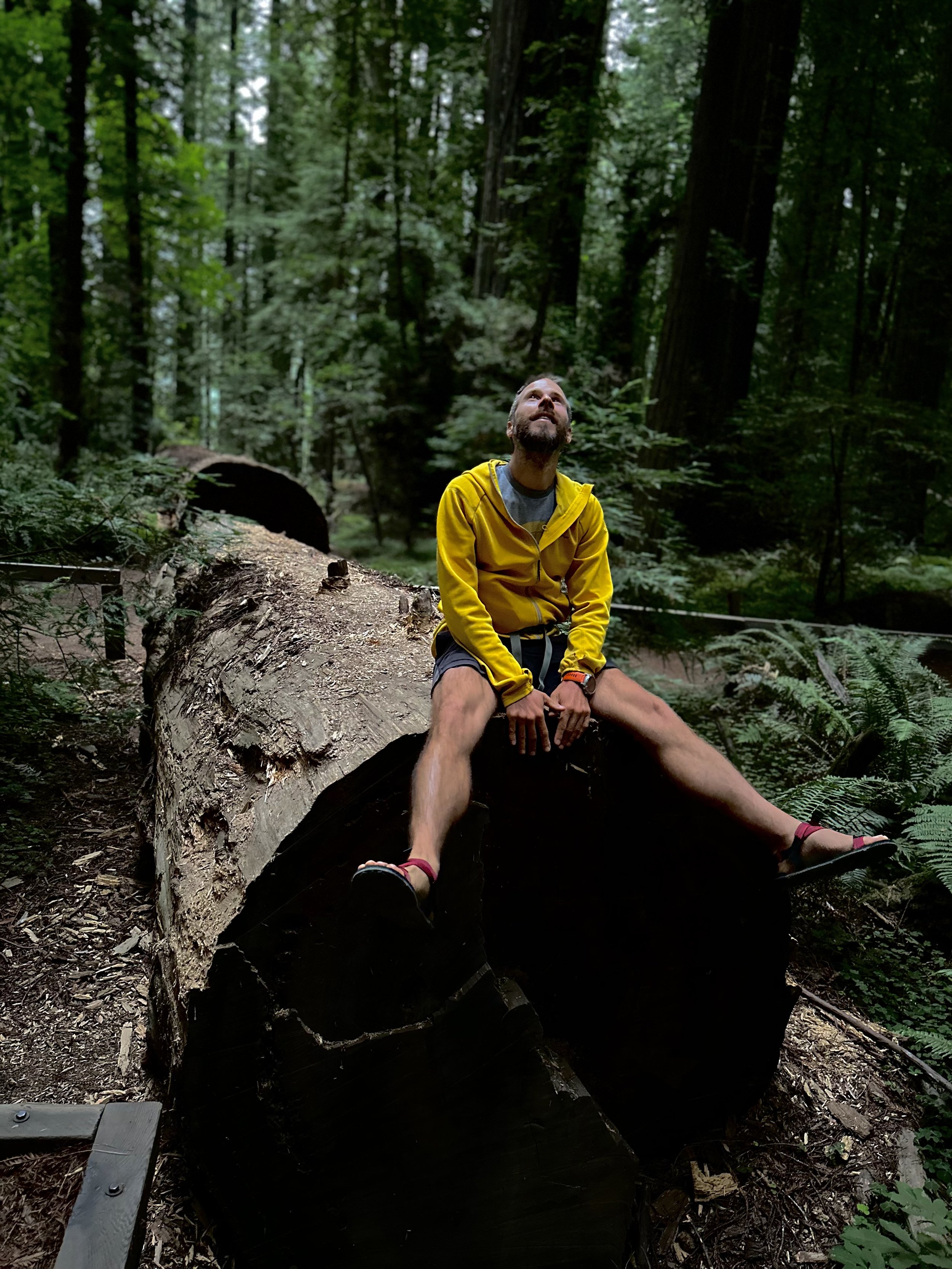On this episode of the podcast, we sat down with the infamous Tom Randall of Wide Boyz fame. Tom reflected on some of the most transformative moments in his climbing career, debunked some of the myths of climbing training, and got us hyped on the AAC’s new partnership and discount with Lattice Training. Whether it's how to train as a trad climber, or the difference that trainers see between UK athletes and US athletes, we covered a broad range of topics. If you’re curious whether you should start training for climbing, even if your goals in climbing have nothing to do with pushing grades, then dive in!
Summit Magazine
Provided by Michael Levy
A story from the AAC Library
By: Sierra McGivney
Jean Crenshaw and Helen Kilness rode their motorcycle away from the US Coast Guard base in Georgia in 1946. They had just taught themselves how to ride the motorcycle in the bike dealership's parking lot. The two had become fast friends working as Radio Operators in the Coast Guard. With the war over, they were untethered, the future and road ahead of them. Both grew up out west, so they headed that way, the wind roaring around them.
Once in California, they worked in the publishing and editing industry, and on the weekends, they went out on trips with the Sierra Club. The two fell in love with rock climbing and playing outside. They were completely inseparable. With time they moved to Big Bear, CA, to an old Forest Service cabin. They wove their two favorite things together and started a climbing magazine, the first of its kind, in 1955.
Summit Magazine was edited, published, and produced in Crenshaw and Kilness's house. The basement contained a dark room for photo and print development.
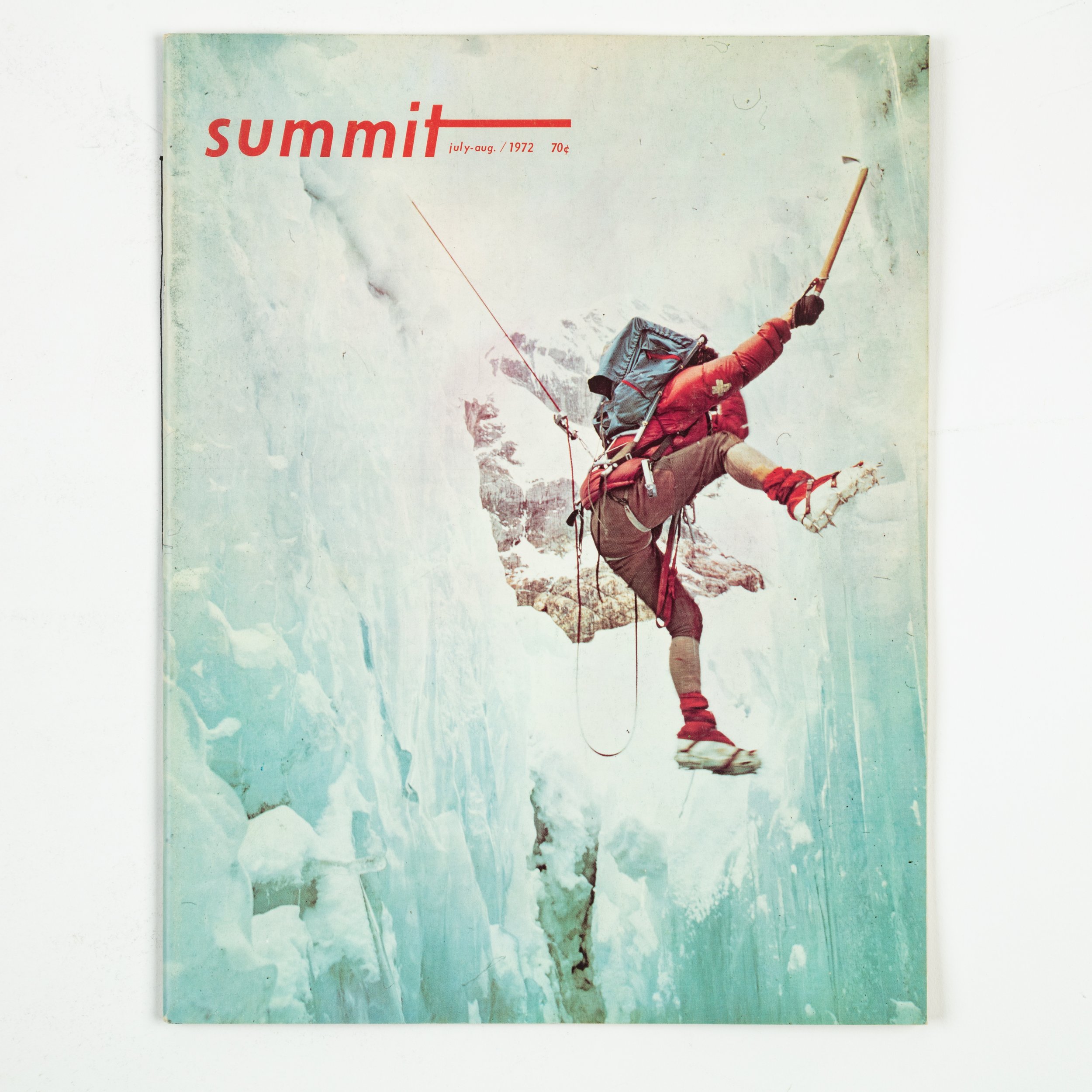
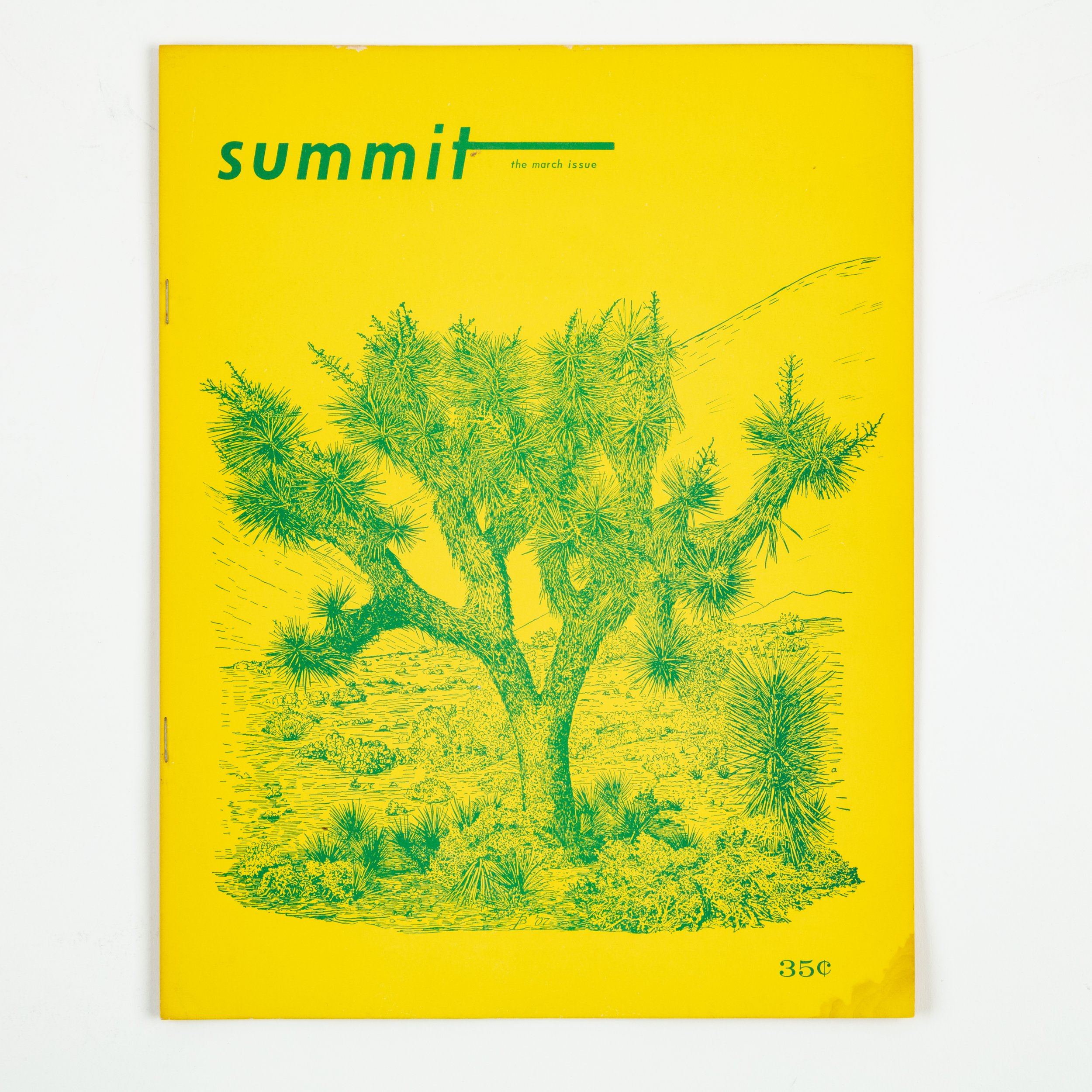
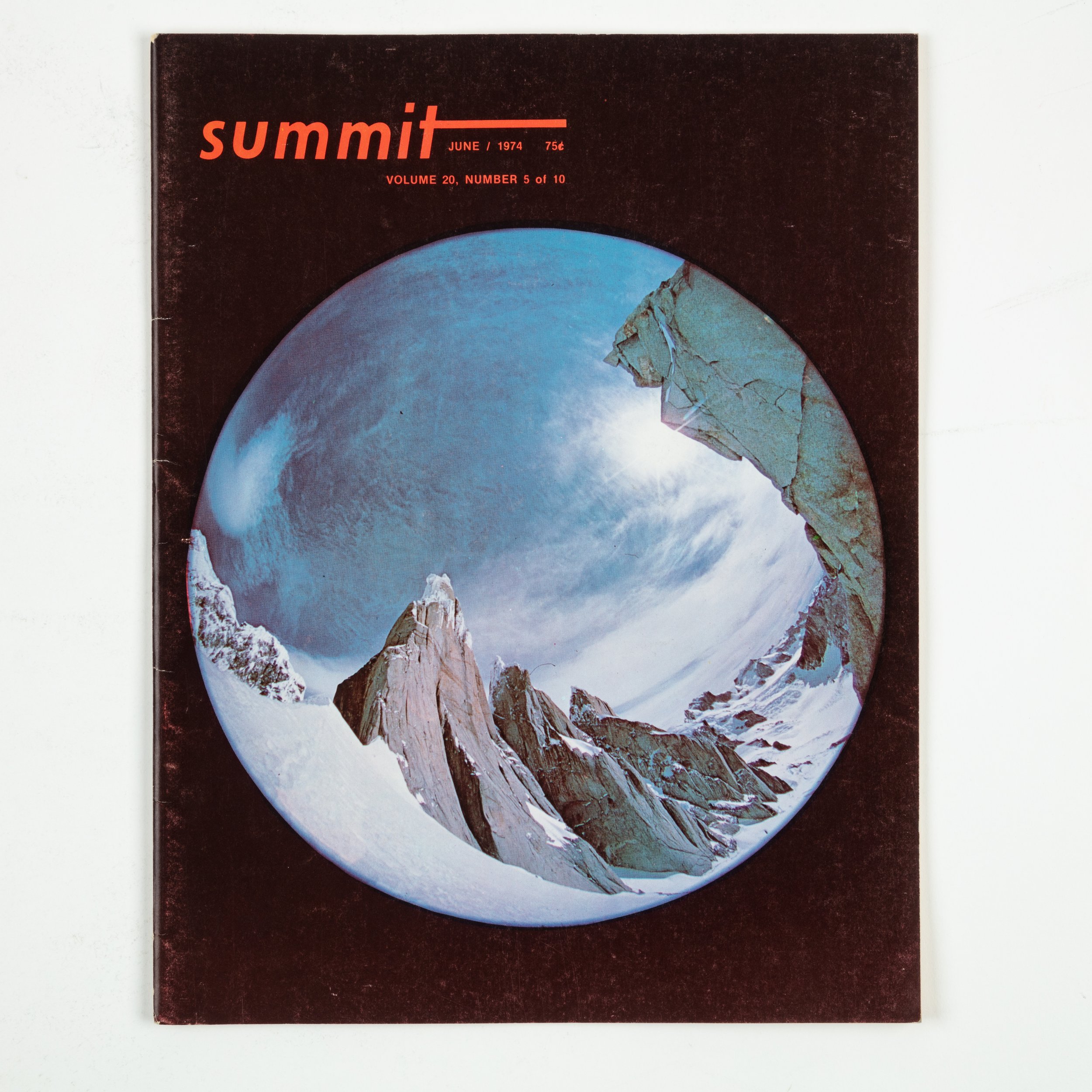
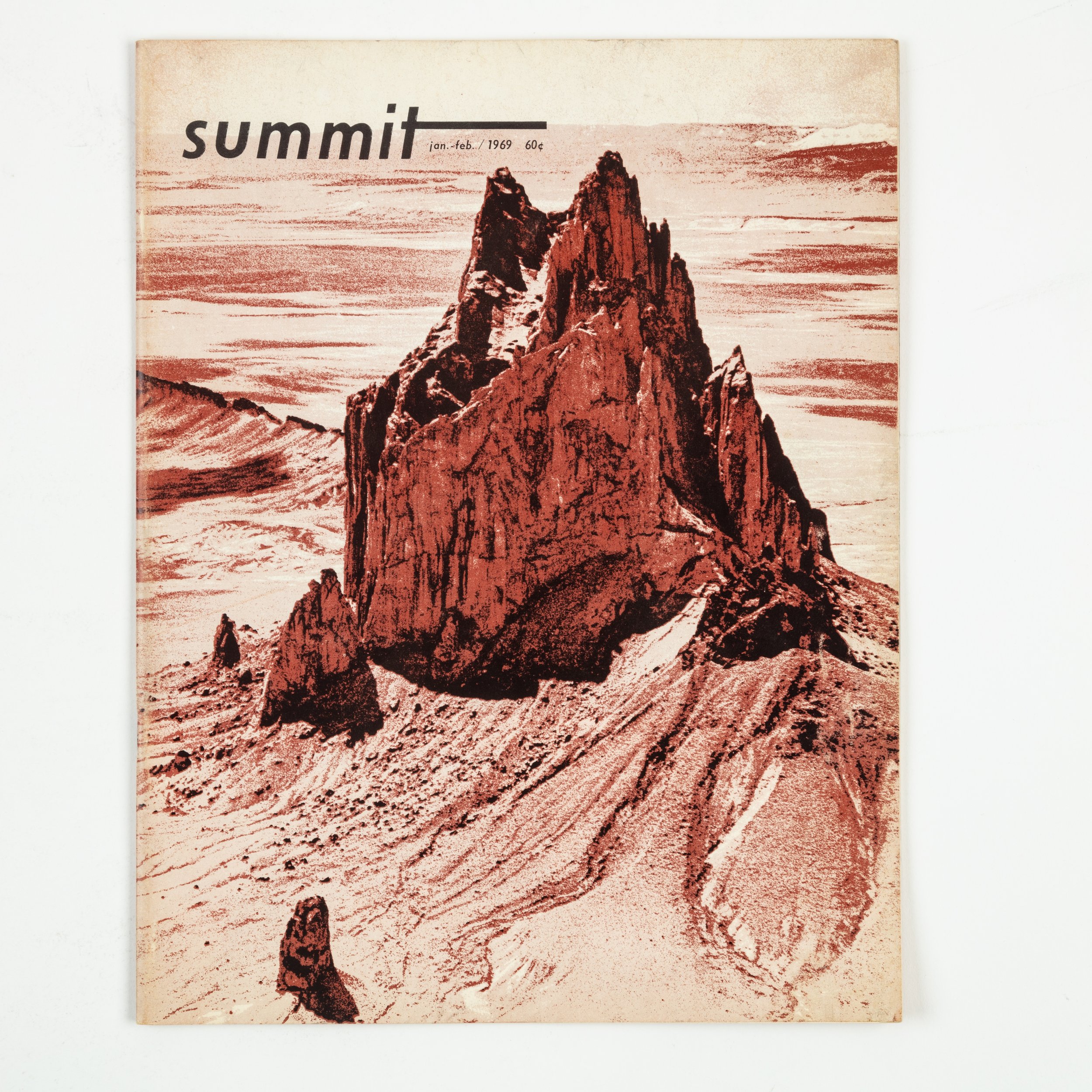

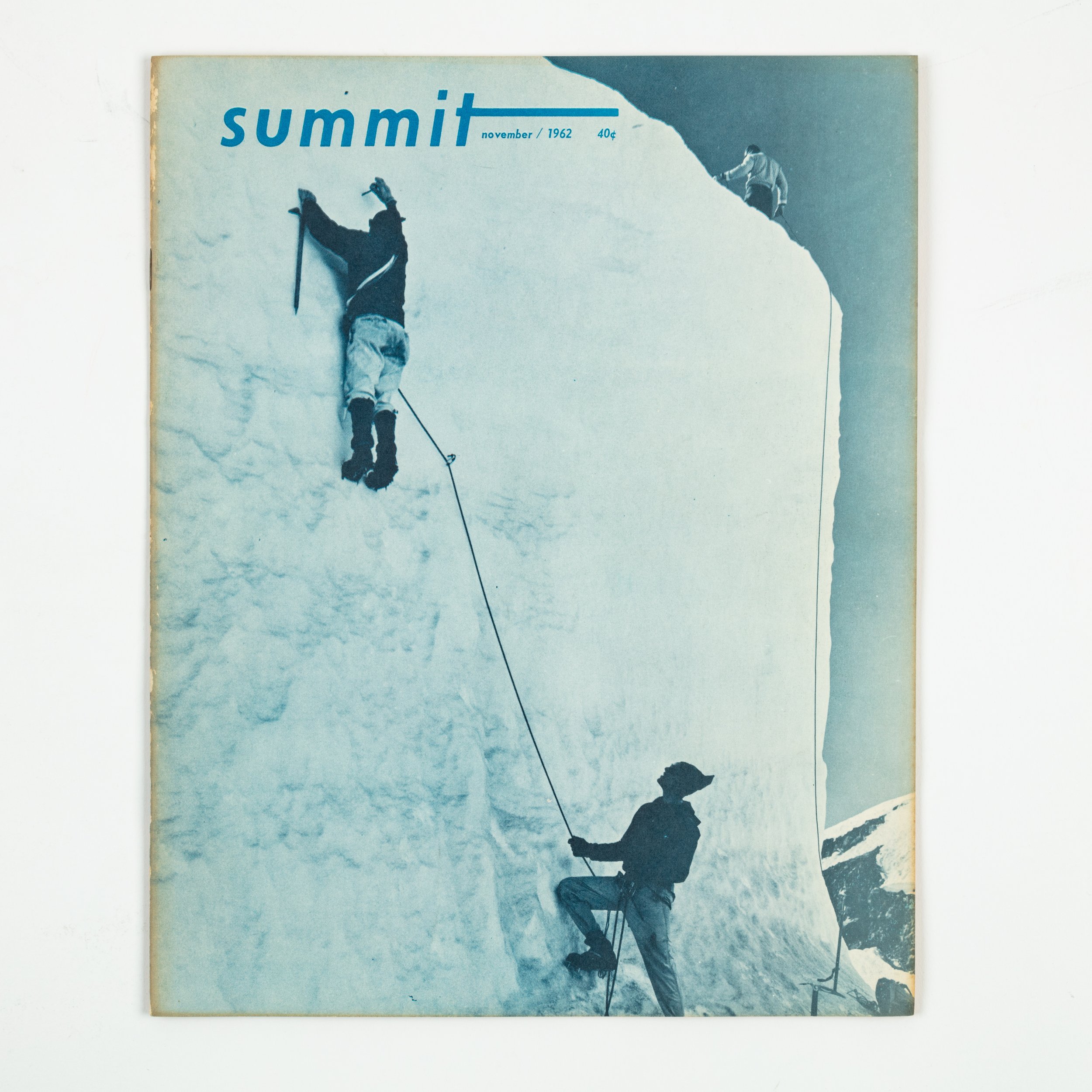
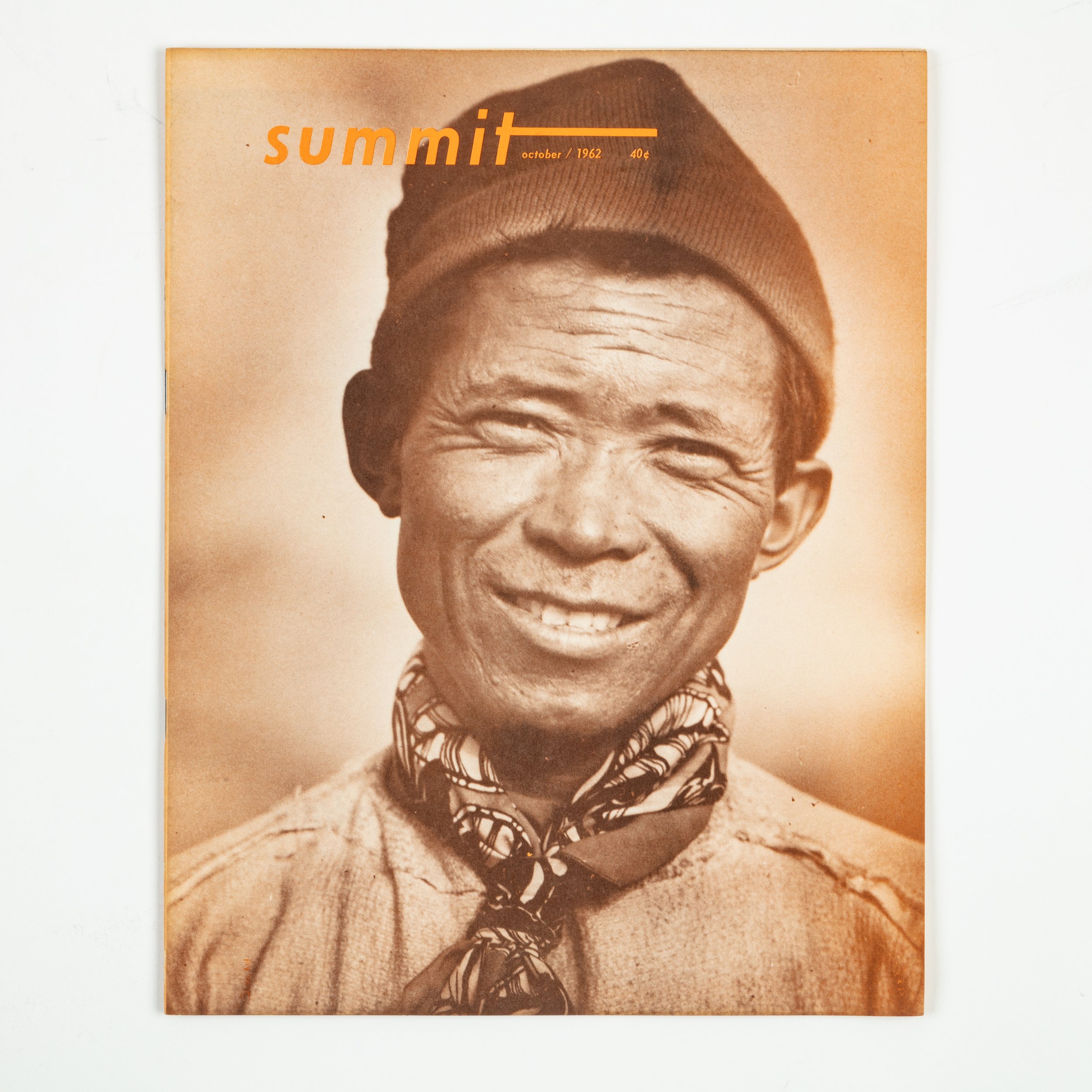

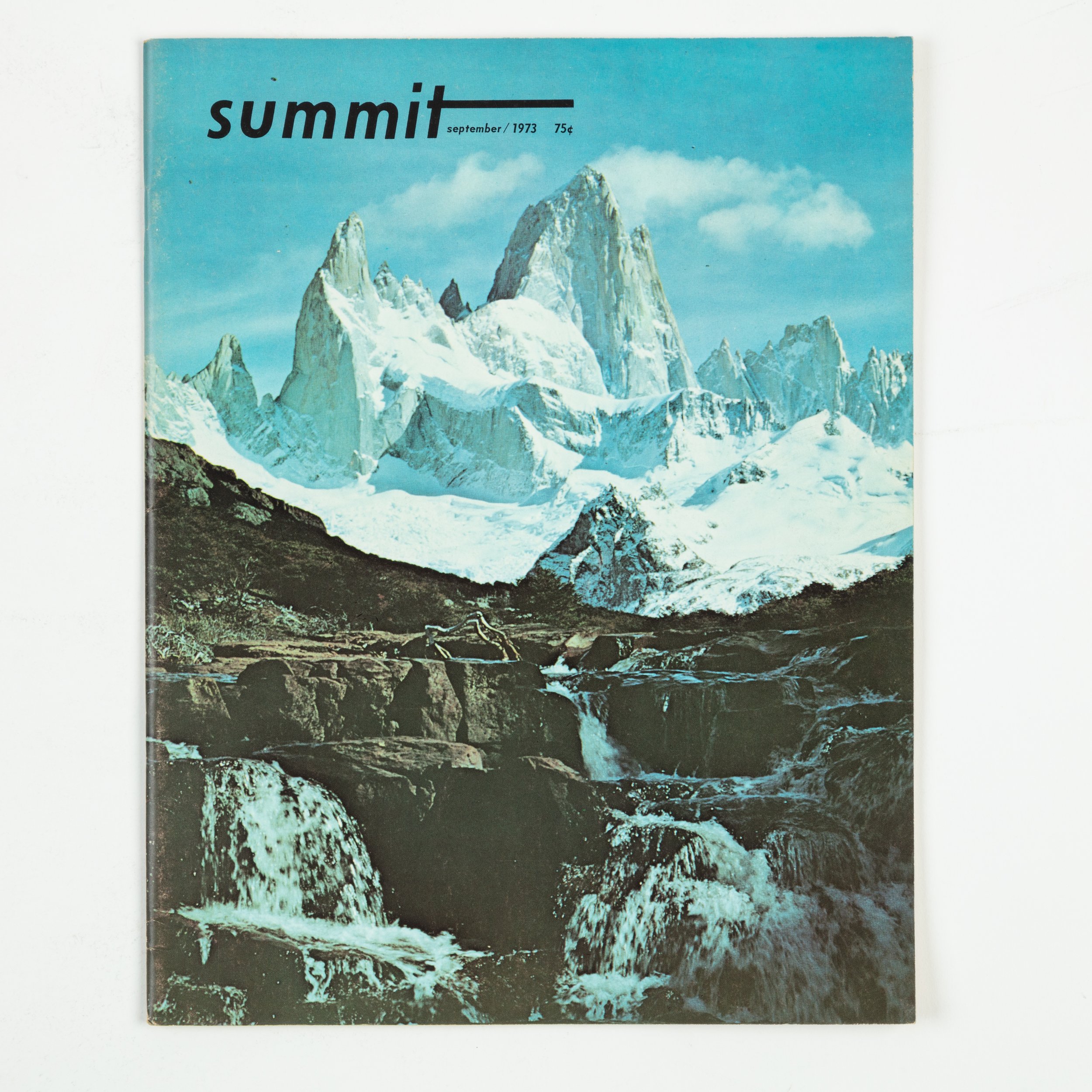
The two were some of the original dirtbags. They would make enough money and write enough content for the magazine and then run away into the mountains and play. Their first magazine cost 25 cents.
In the post-WWII climate of the United States, they went against the grain. Though not against marriage or children, Kilness and Crenshaw were committed to expanding and redefining the purview of women. Alongside the complexities of their religious commitments and their vision for climbing journalism, they were also two women who wanted to throw out the kitchen sink and replace it with summits.
Provided by Michael Levy
Kilness and Crenshaw avoided letting it be known that they were women on the masthead of Summit Magazine. Jean became Jene, and Helen became H.V.J Kilness. Because of this, some men felt free to write letters to the editor, denigrating women. In response, Kilness and Crenshaw would publish these letters and those that would follow, opposing these sexist views. The comments section of Summit Magazine was like the Mountain Project forum of the 1950-70s.
Kurt Reynolds from Denver, Colorado, wrote, "A women's very presence can mean discord and defeat, for rare indeed is the climber who can forget ingrained patterns of chivalry and demand the same grueling performance from feminine teammates that he would from another man. In their mad rush to ape men, women have invaded every field of our endeavor. Let them return to their proper realm of kitchen, children, and church–and be there when we return from the mountains."
The comments section regulated itself, and both men and women expressed their views against this comment.
Elizabeth Knowlton, a famous mountaineer, countered, "But the fact is that to some individuals, of both sexes, mountains, and mountaineering have really important meanings and values—though to many individuals they do not … People vary enormously. If Mr. Reynolds expects half the human race to conform to one single type, strictly determined by their sex, I fear he will meet with disappointment. I speak as a woman who has always been interested in climbing."
Others said in defense of women, "Mr. Kurt Reynolds rather sickened my stomach with his opinions on the female of the human species. I'm sure that no registered nurse would appreciate his statement on women being 'emotionally unstable and notably unreliable in an emergency,'" responded Dick Skultin.
Kilness and Crenshaw probably laughed whenever they received letters addressed "Dear Sir" containing sexist views of the day. Little did the men writing in know that two mountain climbing women ran Summit Magazine.
Instead of outright confronting these individuals, they proved them wrong through every magazine they produced that empowered women.
Provided by Michael Levy
The letters to the editor weren't the only place these nuanced subjects were brought up. In the fictional story "The Lassie and the Gillikin" from the June 1956 edition of the magazine, the author writes about the undertones of sexism in climbing at the time and the expectation for a woman to make herself smaller. In the story, a male climber takes Jenny climbing for the first time. She starts with beginner climbs and every weekend works to climb harder. She persists and becomes better. At one point, when Jenny succeeds on a climb, the male climber does not, and he is suddenly cold towards Jenny. This male climber has lunch with another woman when he usually eats with Jenny. He weaponizes this woman to show Jenny further how much he distastes her success.
Provided by Michael Levy
The Gilikin, a little creature that climbers blame for tangled ropes or slick holds, suggests to Jenny that he push her off a climb to make the male climber interested in her again. Jenny agrees, and after she falls off a climb, his interest in her returns, underscoring the writer's point.
Jane Collard said it best in the July 1956 comments section of Summit: "Men need to feel superior to women, especially in outdoor, rugged, manly-type activities, and a woman mountain climber is liable to give 98% of the male population an inferiority complex because there are so few men who are mountain climbers and also society says mountain climbing isn't feminine."
The richness of Summit was that it was a proving ground for these kinds of hard conversations about equity, but the editors also insisted on doing so playfully.
Flipping through old Summit Magazines, you'll find various cartoons and articles. A person skiing off El Capitan is on the cover of their March 1972 issue. The cover was made to look real with a photo of El Cap and a drawing of a small person with a red parachute skiing off of it. On the inside of the magazine, a complete description: "In a well planned and skillful maneuver, Rick Sylvester skied off the top of El Capitan in Yosemite National Park at approximately 50 mph, then parachuted to the valley floor." You can tell that Kilness and Crenshaw were having fun. They didn't take themselves too seriously.
Oddly enough, an ad for Vasque boots is placed on the outside cover. The ad says, "Vasque…tough books built by men who've been there…Vasque the mountain man boot."
Provided by Michael Levy
The articles in Summit had an extensive range of topics, from challenging technical climbs to backpacking and ecology. The magazine had a news section called "Scree and Talus" which always included a poem. One addition of "Scree" includes a granola recipe next to the information about an unclimbed mountain in Nepal called Gauri Shankar.
The swirly fonts, playful cartoons, and various article topics blended feminine elements into an otherwise 'masculine' sport for its time. Kilness and Crenshaw were redefining climbing to include their vision—broadening and deepening what climbing could mean and who climbing was for.
Summit was about all aspects of climbing, not just climbing difficult grades and training, which are worthwhile stories to tell but do not encompass the soul of climbing, the why of climbing. Summit Magazine was about pursuing the outdoors and having fun while doing it. Summit's depth and earnest silliness came from Kilness and Crenshaw's ability to take a step back from climbing, see their complex role in it, and in turn, climbing's role in life. That philosophical distance certainly takes the edge off the grade-chasing.
When magazines like Rock and Ice (1986) and Climbing (1970) came onto the scene, Summit fell off. Kilness and Crenshaw themselves ascribed this to their competitors' editorial focus on sending hard and putting up new technical routes. But whether cutting-edge climbing simply sells better or it was the usual story of big media winning by sheer resources, the project was no longer sustainable. Killness and Crenshaw sold the company in 1989, the same year the American Alpine Club recognized their contribution and lifetime service to the climbing community. Under new owners, Summit continued until 1996, after which it was discontinued.
You can still be transported to 1974 and look at old photos of beautiful landscapes worldwide. The AAC library holds all issues of Summit Magazine from 1955-1996. These magazines can be an excellent resource for planning trips or a looking glass into a past era of climbing.
Provided by Michael Levy
And Summit's journey continues. Through long-form print media, Summit Journal will be produced twice a year in large format to preserve the richness of climbing storytelling. In a world of clickbait articles, Summit is daring to produce quality climbing journalism and once again encompass the soul of climbing. Hopefully, they can capture Kilness and Crenshaw's playful essence even if someone isn't skiing off El Capitan on the cover. Returning to climbing journalism's roots just might take us to new places.
The Line—July
The Line is the monthly newsletter of the American Alpine Journal.
O CANADA!
Canada is an enticing destination for U.S. climbers: an international locale that’s easy to reach and to navigate, yet with a wilder feel than many of the crowded crags and peaks back home. With the 2023 AAJ going into the mail next month, here’s a teaser from the upcoming edition: five fresh reports from five Canadian provinces and territories.
Seba Pelletti leading pitch eight of Viaje Boreal (650m, 5.11+) in Canada’s Northwest Terriorties. Photo by Pato Diaz.
Northwest Territories
Seba Pelletti, an Australian who resides in southern Chile, traveled to northern Canada last August with three Chilean friends: Pato Diaz, Michael Pedreros, and Hernan Rodriguez. The prime objective was Mt. Dracula, a hulking summit in the Vampire Peaks, about 20 kilometers to the northwest of the famed Cirque of the Unclimbables. This rainy zone rarely sees visitors, but the 2022 team was lucky, with enough good windows to put up three new routes, including a 650-meter line up a previously unclimbed face on Dracula (see photo above), possibly only the third ascent of this isolated peak. Pelletti described their adventures in his story for AAJ 2023.
Photo by Zach Clanton.
British Columbia
Near Terrace, B.C., is a striking granite pyramid known variously as the Shark’s Fin or the Saddlehorn. This peak had been climbed and even skied, but the beautiful southern prow had no known routes. Zach Clanton, Kris Pucci, and Tim Russell changed that last July, with an 11-pitch line that begs to be climbed. The first ascent went smoothly. As Zach wrote in his AAJ report, “Sometimes, very rarely, even with all of the mysteries intact, things go according to plan…. We had no brushes with death, no dicey bear encounters, and no stories of terrifying choss. And that’s just how we like it.”
Alberta
Sam Wall’s family used to run one of the backcountry lodges at Amethyst Lake in the Tonquin Valley of Jasper National Park, below the incredible quartzite walls of the Ramparts. (Those lodges were closed recently in an effort to protect a small herd of caribou in the valley.) During his years of staring at the walls, Sam picked out a possible new route up the northeast face of Oubliette Mountain. In August, he and Shep Howatt rowed across the lake to access the face and succeeded with a 900-meter new route (5.10-) to the summit. After a bivy on the ridge, they traversed along the Ramparts to climb the north ridge of Bennington Peak, also a first ascent. Read Sam’s report here.
High on the northeast face of Mt. Oubliette during the first ascent, with Amethyst Lake below. Photo by Sam Wall.
Newfoundland
Silas Rossi on Delirium, one of the new routes at the Bear’s Den near Parsons Pond in western Newfoundland. Photo by Ryan Stefiuk.
New Englanders have been making the trek to western Newfoundland for decades to explore the East’s biggest ice climbs. (See Alden Pellett’s Recon story in AAJ 2021 for the climbing history of this area.) In 2022 and 2023, a rotating crew of Northeastern U.S. climbers has focused on Parsons Pond, a remote area accessed by snowmobile. Ryan Stefiuk reveals the goods in AAJ 2023.
Nunavut
From Baffin Island in Nunavut Territory comes our final AAJ teaser: a short video about a new route up the northeast face of Mt. Turnweather by Neil Chelton, Owen Lee, and Maria Parkes. This fun look at expedition life was edited by Chelton, creator of the VDiff instructional website. Rainy Day Dream Away, the 20-pitch route they climbed, takes a direct line to the east ridge of Turnweather, a route first climbed in 1977 by former AAC vice president Clark Gerhardt and Craig McKibben. The full story of last summer’s ascent will appear soon in the 2023 AAJ and at our website.
THE 2023 COVER: A FAMILY AFFAIR
As the AAJ is being prepared for mailing, here’s a preview of the 2023 cover, showing a precarious stance on Shield of Dreams (5.13b), one of several hard new routes climbed last year on Trapezoid Peak in the High Sierra. The climber is Chase Leary, who, as Andy Puhvel writes in his AAJ report, is “a local granite master whose wizardry on the rock has earned him the nickname ‘Swami.’ Chase’s family goes back three generations in the Eastern Sierra, and his father, Kevin Leary, was one of the first climbers to establish the 5.12 grade in Tuolumne and the Eastside.”
Puhvel also has multi-generational family ties to the Sierra: He and Lisa Coleman ran the Yo! Basecamp Rock Climbing Camp in these mountains for more than 20 years, and they still operate the Nor Cal Youth Climbing League, the longest running competition series in North America. And their son, Cashus, shot this year’s spectacular cover photo!
Join the Club—United We Climb.
Get the AAJ Sent to You Annually
Partner-level members receive The American Alpine Journal book every year. Documenting mountain exploration and the year’s most significant ascents through first-person reports and photos, it’s an essential historical record and a feast of inspiration.
Rescue & Medical Expense Coverage
Climbing can be a risky pursuit, but one worth the price of admission. Partner-level members and up receive $7,500 in rescue services and $5,000 in emergency medical expense coverage. Looking for deeper coverage? Sign up for the Leader level and receive $300k in rescue services.
THE HUNTINGTON SPECIAL
The Technicolor Super Dream on Mt. Huntington. Photo by Zac Colbran.
The latest Cutting Edge podcast highlights three young climbers from the U.S. and Canada—Zac Colbran, Dane Steadman, and Grant Stewart—who found a beautiful and challenging new route up the west face of Mt. Huntington, one of North America’s most iconic peaks. Listen here.
Sign Up for AAC Emails
The Line is the newsletter of the American Alpine Journal (AAJ), emailed to more than 80,000 climbers each month. Find the archive of past editions here. Interested in supporting this online publication? Contact Billy Dixon for opportunities. Questions or suggestions? Email us: [email protected].
CLIMB: Behind the Scenes of the USA Climbing Training Center
In this episode of the podcast, we’re featuring a conversation between guest host and AAC board member Cody Kaemmerlen, and USA Climbing’s Head Coach, Josh Larson. Cody and Josh hang out at the USA Training Center to record this conversation, and talk team culture, behind the scenes of comp training, and even a bit about how the Olympics is shaping competitive climbing. This isn’t your typical training podcast. We’re taking a deep dive into the inner workings of an ever evolving and cutting edge part of our sport. Listen in to get some insights on the philosophy powering the USA Climbing Team, from the coach who trains some of the best climbers in America.
The Line — June 2023
The Line is the monthly newsletter of the American Alpine Journal.
Vitaliy Musiyenko following pitch six (5.11), one of the cruxes of Against the Grain on Charlotte Dome. Photo by Brian Prince.
THE BEST 5.11 IN THE HIGH SIERRA?
“Over the last couple of years, I’ve been working on a route which, in my honest opinion, has the potential to become known as one of the five best 5.11s in the High Sierra.” That’s the start of Vitaliy Musiyenko’s report for AAJ 2023 on Against the Grain, a new route up Charlotte Dome in California’s Kings Canyon National Park. Musiyenko, co-author of the new High Sierra Climbing guidebooks, and Brian Prince completed the 1,800-foot 5.11c route in late July of 2022.
“I had just developed COVID symptoms on the day we hiked into camp at Charlotte Lake,” Prince wrote in an email, recalling the first ascent. “The next day, when we climbed the route, I was really pretty wrecked. I think the only way I was able to keep climbing was that the route was so good. I put on a mask at the belays to try and protect Vitaliy, but he ended up testing positive a few days later anyway. It says a lot about Vitaliy that he didn't hate me for giving him COVID when he avoided it after working through the height of the pandemic in an emergency room.”
Against the Grain has about 1,800 feet of climbing on the southeast face of Charlotte Dome. The “Fifty Classics” South Face route ascends the corrugated face to the left. Photo by Vitaliy Musiyenko.
Prince added, “I just felt grateful that Vitaliy asked me to join him to climb the route after he put so much work into it. It felt like a kind of peak in our partnership because he would be moving out of California [to Utah] soon after.”
Against the Grain takes a direct line up the southeast face of Charlotte Dome, well to the right of the classic South Face route (Beckey-Jones-Rowell, 1970), and also to the right of Dance of Dragons, a route that Musiyenko established in 2017 with Jeremy Ross. Curious about the claim that the new route might be among the best 5.11s in the High Sierra, we asked Musiyenko and Prince—two of the Sierra’s most active first ascensionists—to fill out their top five. Perhaps unsurprisingly, they agreed on most of the climbs. Here’s their list in alphabetical order:
Against the Grain (Charlotte Dome) • Friends (Spring Lake Wall) • Positive Vibrations (The Hulk) • Tradewinds (The Hulk) • Valkyrie (Angel Wings)
Prince also mentioned Sky Pilot on Mt. Goode and Sword in the Stone on Mt. Chamberlin, but added that he hadn’t done the latter. He said the new route on Charlotte Dome might be the best of them all: “Not just the top five…. It is vertical face climbing on a backcountry granite dome for pitch after pitch. There's just nothing else like it.“
Do you have a favorite long 5.11 in the High Sierra that ought to be on this list? Name it in the comments below.
The south side of Cerro Iorana at sunset. Photo by Andrew Opila.
THE WILDS OF TIERRA DEL FUEGO
In a “Recon” article for AAJ 2020, geographer and exploratory climber Camilo Rada described the history and climbing possibilities in the remote Cordillera Darwin of Tierra del Fuego, at the southern tip of South America. Inspired in part by this article, Spanish climbers Eñaut Izagirre and Ibai Rico organized an expedition to the Cordillera Darwin in 2022 to attempt unclimbed peaks and study the snow and glacier dynamics in the range. With a base camp aboard the yacht Kotik, the seven-person expedition found great success, making the first ascents of the central summit of Monte Roncagli and Cerro Sara, as well as a new variation on Monte Francis. The team also collected snow samples from extremely remote sites and recovered thermometers and recording devices placed by Izagirre during a previous expedition in 2018. Among the early findings: The Roncagli (Alemania) Glacier has retreated at the alarming rate of more than a kilometer in just four years.
Izagirre and Rico’s article about the expedition will appear in AAJ 2023, which will be mailed to AAC members at the end of this summer. In the meantime, here’s a gallery of the team’s photos from the wild and beautiful Cordillera Darwin.
Photographer and climber Andrew Opila has produced a 30-minute film about the expedition, Into The Ice, which premiered in Bilbao, Spain, and was shown at the Wasatch Film Festival in April. More festival dates are pending. See the trailer here.
THE CUTTING EDGE IS BACK!
Season five of the AAJ’s Cutting Edge podcast kicks off with an interview featuring Jackson Marvell, the 27-year-old alpinist from Utah who just climbed his second new route up the mile-high east face of Mt. Dickey in Alaska. Listen here or wherever you get your podcasts.
The Line is the newsletter of the American Alpine Journal (AAJ), emailed to more than 80,000 climbers each month. Find the archive of past editions here. Interested in supporting this online publication? Contact Billy Dixon for opportunities. Questions or suggestions? Email us: [email protected].
How to Dream up the Next Cutting-Edge Thing
PC: Jeff & Priti Wright
By: Sierra McGivney
First ascents and new lines on faraway mountains fill the American Alpine Journal every year. American Alpine Club members and climbers in the community browse the AAJ annually, reading stories about cutting-edge ascents. Some might even wonder to themselves, how do you dream up the next cutting-edge thing?
Beyond producing the AAJ, the American Alpine Club has a legacy of encouraging and inspiring climbers to push their limits and dream big through our grants. In 2022, Jeff and Priti Wright won our Cutting Edge Grant, sponsored by Black Diamond, to attempt K7 Central. This year, Lindsey Hamm won the Cutting Edge Grant and also our McNiell-Nott Grant, sponsored by Mountain Hardwear. They are each cutting-edge alpinists who are in pursuit of world-class climbing and mountaineering objectives. And they have answers to the questions you've been wondering about.
Step One: Light the Fire
Priti and Jeff Wright are a wife and husband duo based in Seattle who have been featured in the AAJ three times and on The Cutting Edge podcast. Their blog Alpine Vagabonds details their first ascents, alpine endeavors, and how-tos. Some of their most notable accomplishments are the first ascent of K6 Central (7,155m), the third ascent of K6 West (7,140m), all four peaks of Patagonia's Torre Range, and "The Six Classic North Faces of the Alps." But how did two-weekend warriors become cutting-edge alpinists?
Jeff and Priti on K6. PC: Jeff & Priti Wright
In 2017, The Mountaineers, a nonprofit climbing club based in the Pacific Northwest, held a talk featuring Graham Zimmerman, professional alpinist and AAC president, at their local gear shop in Seattle. It inspired the Wrights, so they approached him after the talk. Over drinks with Zimmerman, they talked about planning trips and their goals. They were excited about doing something new. The Greater Ranges in the Himalayas had caught their attention.
They asked Zimmerman about K6 Central, which he had attempted. They were interested in climbing it themselves. Zimmerman said something along the lines of, "Go send that sh*t." The two were stoked that Zimmerman had been so encouraging and kind.
"In the climbing community, almost everyone you reach out to is friendly and nice because they were in your position at one point," said Priti.
So for their first trip, they rode Zimmerman's coattails. According to Jeff, this is fairly common in the climbing community—failed expeditions can be a great opportunity for someone looking to make a first ascent. But you don't want to scoop someone's line, so contact the person first and see if they will make a second attempt at it. If they aren't planning to, they might even help you out and give you some extra beta.
Step Two: Plan An Expensive Glorified Camping Trip
On this first trip to Pakistan to climb K6 Central, Priti and Jeff learned a lot. Big expeditions are like glorified camping trips with lots of extra stuff, according to the Wrights.
PC: Jeff & Priti Wright
Logistics to be considered when planning a big expedition are:
Visas
Permits
Tour operators
Satellite devices
Weather
Power sources
Budget
Food
Shower
Washing clothes
They use spreadsheets and checklists to stay organized. Once you've figured out logistics, you can focus more on the climbing or technical aspect of your trip. The two got a lot of advice from Steven Swenson and Colin Haley on what food to bring and what airlines have the best baggage deals. Knowing someone who has gone on an expedition before can be a huge asset.
If you're wondering how to budget and get your trip funded, look into mountaineering grants. The AAC has quite a few for all different types of trips. Mountaineering or skiing/splitboarding based? We got you. Research or breaking barriers based? We got you. Have a climbing dream of any kind? You guessed it—we have a grant for you.
Step Three: Leave No Trace? Leave the Right Trace.
This is Lindsey Hamm’s second trip to the Churakusa Valley. This year, she's backed by the Cutting Edge Grant and the McNeill-Nott Grant.
"I'm thankful and grateful to have another opportunity," said Hamm.
Last year she, Dakota Walz, and Lane Mathis established a first ascent on a formation between Spanster Brakk and Naisa Brakk (which they named Ishaqu Brakk): Pull Down the Sky (15 pitches, 5.11 R).
Hamm is always excited about seeing the porters, cooks, and guides she's worked with again and continuing to build a relationship with the community in the valley. There is beauty in being around people who have a different life than hers. She becomes a student again.
This year, Hamm's group is bringing over school supplies and paying teachers their salaries for the year. For Hamm, climbing is about community, not just the climbing community.
Jeff and Priti have the same attitude. They advocate for climbing responsibly and contributing to the community where they are climbing. Alongside Steve Swenson, they work with Iraq Fund, an organization that helps girls go to school.
"It's not just about 'how you can help the climbing community' but the greater community as well," said Priti.
Step Four: Listen Closely for Unclimbed Peaks
K7 Expedition. PC: Jeff & Priti Wright
For the Wright's 2022 K7 Central trip, expectations were low. The idea was original and supported by the Cutting-Edge Grant. The inspiration for this trip was found at another mountaineer's talk. This time it was Steven Swenson who presented. He mentioned that K7 Central was unclimbed. They noted this and added it to their list of climbing ideas. There was a limited amount of information out there once they started looking into it. But that didn't deter them in the slightest.
"It's so difficult to try to come up with your own original idea in the Greater Ranges," said Jeff.
Half of the work is finding an objective that has yet to be done. Many of the Greater Ranges' mountains have little information on them, so it takes a decent amount of work just to look up a mountain and see what's been done.
The Wrights have spent hundreds of hours looking through documents in the AAC Library and the AAJ, searching for information on cutting-edge ascents. The AAC library uniquely holds so much history and resources for planning expeditions.
With a lack of information, the expedition became exploratory. They were unsuccessful in 2022 but are going to go back this summer to try K7 Central again.
Step Five: Devour Audio and Video Inspiration
"Getting inspired by listening to podcasts like The Cutting Edge and following people on Instagram, reading things that people have written, makes it seem a little more possible, and it gets those gears turning of, well, what might I be able to do?" said Priti.
Jeff and Priti's go-to podcasts to feed the stoke:
The Cutting Edge podcast
The Run-Out
Climbing Gold
The Enormocast
Alpinist
The Firn Line
Uphill Athlete
Evoke Endurance
Training for Climbing
Books:
The American Alpine Journal
Seriously, the AAJ contains trip reports for areas relevant to your expedition—Lindsay, Priti, and Jeff each swear by it.
Anything relevant in the AAC Library
Training for the New Alpinism: A Manual for the Climber as Athlete
Training for the Uphill Athlete
Step Six: You've Figured Out Where You Want to Go—Time to Train
For the last six years, Jeff and Priti have been in the Uphill Athlete Program, a training program with daily workouts made for different uphill pursuits. You might have seen or read the book Training for the Uphill Athlete; essentially, this is an extension of the book. They have been focusing on the endurance aspect of training and bringing it into the mountains. The biggest thing for them when putting together a plan is to focus on their goal.
"You have to break it down to, what are you training for? What are the exact specs of the thing you want to do?" said Priti.
PC: Jeff & Priti Wright
If your goal involves a lot of steep inclines, get your cardio high. At altitude, that's what you'll start losing first. If your goal involves a lot of technical climbing, you'll want to focus on strength training. At a certain point, you’ll have enough technical skills to accomplish your objective, and you can focus more on your muscular endurance and aerobic capacity.
The Wrights have big long objectives, so they focus on endurance-type training. Training is a huge part of alpinism or any big objective. It can help mitigate some risks. When you're at altitude and stressed out, having a reserve of energy can be huge.
"This weekend, all of our friends are going out rock climbing, and I'll be carrying a heavy pack up a steep muddy trail; just very monotonous and antisocial," said Jeff. "But it's nice to have a big objective that you're working towards."
Priti keeps a photo of her climbing goals or objectives on the background of her phone and on her credit card. It's a reminder of what she's working towards and saving up for.
Step Seven: Build Partnerships and Positivity
The Wrights have the benefit of being married to their climbing partner. They live together so they can feed off of each other's excitement. They know each other extremely well and know their communication style. Their situation is unique. The majority of partnerships don't have this dynamic—but one piece of advice that can be applied to every partnership? Don't share negative thoughts.
PC: Jeff & Priti Wright
"You can always put a positive spin on something," said Priti.
If you're not stoked about something, ask yourself, is this really worth sharing? Expeditions can be miserable but well worth it. Keeping both your energy and the energy of others high can be a huge factor in completing your goals.
There is also a balance between sharing safety or logistical concerns and being negative. If you are concerned for your or your group's safety, definitely speak up. Take your time with safety skills when training, too. They are necessary out in the mountains. To keep up their skills, Jeff and Pritit teach classes on climbing safety skills through BOEALPS. What's that old saying? The best way to learn is to teach.
If you enjoy learning, try and find a local group or guiding company that teaches mountaineer or alpine skills. At one point, Jeff and Priti were in a program run by Steve Swenson designed to instruct and mentor up-and-coming alpinists. Listening to Swenson's stories inspired the two. Knowing someone who had climbed in the alpine a lot made it feel more possible.
Step Eight: No Really, Partnership is Crucial
"I'm in four different relationships, and that is with all of my climbing partners," said Hamm.
She likens these relationships to romantic partners. She speaks with each of them on a daily basis to build trust and learn how each communicates. Expedition partners add another layer of friction, good and bad. They need to be able to adapt, work and think as a group. After the trip, Hamm's goal is to return together as a healthy family.
"I'm hype-girl Hamm," said Hamm.
She's also building a relationship with the mountains, getting to know the valley and Pakistan. She's trying to understand what friction exists there, whether that is the political climate or the actual climate.
Step Nine: Seek the Friction
In climbing, friction is all around us. It's created by partners, belay devices, knots, and the climbing rubber on our shoes.
"I think the fact that I have created a little bit more friction for myself …[allows me to seek] a different level of climbing that I've never experienced," said Hamm. "I have taken a lot of time to learn on a smaller scale to be able to go bigger."
Photo provided by Lindsey Hamm.
For Hamm, this isn't her first pitch. This is a culmination of ten years of guiding, learning, and understanding the disciplines: big wall climbing, skiing, ice climbing, mixed climbing, trad climbing, and glacial travel. Big expeditions take her out of her comfort zone and create a new layer of friction: the unknown.
"I really like the unknown," said Hamm with a smile.
She's on her way to the Black Canyon of the Gunnison to train for her upcoming trip. Her focus for this trip will be to work on her breathing, moving slowly and more meticulously. The Black Canyon is a lot like Pakistan—very adventurous, and strengthens the fingers.
"You can feel how the pioneers did it," said Hamm.
She'll head to Washington after The Black for altitude training, a different type of friction. Donning a heavy pack, she'll spend days going up and then down, acclimatizing to higher altitudes. The friction here is not seen but felt in the lack of air and the final push of training.
The environment, the people, and the climbing excite her. She looks over old photos and her grant proposal to stay motivated, but in general, she is a highly motivated, goal-oriented person, in part because of her ADHD. This trip is her lead, her idea.
"I'm living my dream," said Hamm.
Livin’ the Dream
PC: Jeff & Priti Wright
For Priti, Jeff, Lindsey, and many others, these expeditions are their dreams. They all started out learning and honing their skills: the tuned eye it takes to notice a first ascent opportunity; or leveraging and learning from the friction as they pushed harder and harder. They explored what motivated them and what made them excited.
Seek out what excites you the most. Go to talks, read books, and listen to podcasts that inspire you. Be comfortable being uncomfortable. Soon those stunning lines on faraway mountains won't seem so far away anymore.
The Line — May 2023
The Line is the monthly newsletter of the American Alpine Journal.
Bivouac on the southwest face of Ingolfsfjeld during the ’75 expedition. Photo by Jim Davenport.
GREENLAND’S GIANT MYSTERY WALL
The huge southwest face of Ingolfsfjeld, with 63 pitches of climbing, after a snowstorm. Photo by Steve Chadwick.
In the early to mid-1970s, one of the great challenges of arctic climbing was the southwest face of Ingolfsfjeld, an enormous wall 120 kilometers northeast of Tasiilaq on Greenland’s east coast. Visible from the sea, the peak was first climbed by its northeast ridge in 1971, by a Croatian duo, but the biggest face—rising at least 1,200 meters—remained unclimbed despite several attempts.
In 1975, a six-person British expedition finally succeeded, with three of the climbers making the final push to the summit. The resulting route had around 2,000 meters of climbing and was graded ED+ UIAA VI+ (5.10) A3, an extremely difficult wilderness wall for the era. Yet the climb has been largely forgotten, and until this year, no account had been published in the AAJ.
Expedition member Steve Chadwick has described this remarkable expedition at length in a previously unpublished article, now available at the AAJ website, along with photos, a topo, and a pitch by pitch summary of the 63-pitch climb, which likely has never been repeated. (The last known attempt on any route up the mountain was in 1986!) An overview of the 1975 climb, written by senior editor Lindsay Griffin, will appear in AAJ 2023, which will be mailed in late summer.
Introduction to Keith Myhill’s pitch-by-pitch description of the route, which totaled 6,640 feet of climbing. A link to the full description is in Steve Chadwick’s article at our website.
MINI-EPIC(S)
Mark Allen starts the team’s ascent of Chimaphila (470m, IV AI4) on Black Spire in the North Cascades. Photo by Jesse Charles.
Winter climbing is hard on climbers—and on their approach vehicles. Last winter, Mark Allen, Jesse Charles, and Seth Keena snowmobiled about 25 miles along closed Highway 20 in the North Cascades to make the first ascent of the east face of Black Spire by a varied ice line. Late in the day, they skied back to the unplowed road and mounted their sleds for the ride back to the car. Soon, the troubles began.
Keena opens his report for the upcoming AAJ 2023 with a description of his body slamming into the handlebars of his 1999 Yamaha Phazer. “I had acquired my snow machine for a bargain price, with the caveat that it had an ‘intermittent electrical issue, but not that big of a deal.’” he wrote. “Now, while cruising at 55 mph, the engine and lights had cut off, bringing sudden darkness and deceleration.”
Keena restarted the sled and followed his partners toward the plowed road. “Eventually we all made it back to Mark’s truck at the end of the plowed highway,” he wrote. “But, once again, we quietly faced the power of winter when we discovered the truck’s battery was dead.”
At least their phones still worked. A pleading call summoned help. Said Keena: “A friend is someone who, at 11:30 p.m., leaves their warm bed and drives to the end of the highway to jump-start your dead battery: Thank you, Patrick Murphy, you are a true friend.”
Without apparent irony, they called the new route Chimaphila (“winter lover”). Read Keena’s full AAJ report here.
Join the Club—United We Climb.
Get the AAJ Sent to You Annually
Partner-level members receive The American Alpine Journal book every year. Documenting mountain exploration and the year’s most significant ascents through first-person reports and photos, it’s an essential historical record and a feast of inspiration.
Rescue & Medical Expense Coverage
Climbing can be a risky pursuit, but one worth the price of admission. Partner-level members and up receive $7,500 in rescue services and $5,000 in emergency medical expense coverage. Looking for deeper coverage? Sign up for the Leader level and receive $300k in rescue services.
DENALI’S EAST BUTTRESS:
A 60-YEAR RETROSPECTIVE
Some years ago, Peter Lev, one member of the team that made the first ascent of Denali’s east buttress, published a photo-filled retrospective of the expedition. Lev summited on May 25, 1963, along with Rod Newcomb and Al Read. The other teammates were Warren Bleser, Jed Williamson, and Fred Wright. Here, we bring Lev’s images to light with a gallery of the marvelous photos from his piece. (Click on the images for captions.) You can download the complete retrospective in PDF form by following a link at the end of Read’s feature article in the 1964 AAJ.
Shop the AAJ Collection
Sign Up for AAC Emails
The Line is the newsletter of the American Alpine Journal (AAJ), emailed to more than 80,000 climbers each month. Find the archive of past editions here. Interested in supporting this online publication? Contact Billy Dixon for opportunities. Suggestions? Email us: [email protected].
The Power of Beginning Again: Reflections from the USA Ice Climbing Team
Chelsea Kyffin and Jessica Perez jogging to warm up near the World Cup competition structure in Champagny-en-Vanoise, France. PC: Ryan McCauley
By Ryan McCauley (she/her)
“I mean this in the nicest way possible,” my teammate Marian Prather said, hesitating to finish their sentence. “But this experience kind of reminds me of helping my Mom with social media.” I erupted with laughter as I glared at my iPhone screen in the middle of a South Korean coffee shop, mouth agape, processing the newly learned fact that it was impossible to edit a posted Instagram story (that I had just spent 45 minutes carefully crafting with a lot of hand-holding from Marian and another friend on the USA Women’s Ice Climbing Team). I wrinkled my nose and jokingly prodded back, “Your Mom sounds cool. Is she also 35?”
This was Ryan's third and final speed run in women's finals in the World Cup in Saas-Fee, Switzerland. PC: UIAA Livestream
It was honestly the first time that weekend that I had truly relaxed, given myself permission to sit with the ridiculousness of the moment, and allowed joy to creep in. I had been too busy focusing on the pressure of my performance expectations at the first UIAA Ice Climbing World Cup of the ‘22-’23 season. Sadly, this anxiety was quickly replaced by disappointment as the results started rolling in. Nothing like training for months and flying across the world, only to fall off one swing into the speed climbing competition or slip off a lead move I had done numerous times at the training gym back home, to make me question my efforts. Although it was only my second season competing, my hopes had exceeded reality. Beginner or not, I should have done better.
If I was being honest with myself, the desire to make my Instagram story perfect by zooming in on every detail was representative of more than just my mindset at the South Korean World Cup. As a woman who has been drawn to sports historically dominated by athletes identifying as male, I have often leveraged perfectionism as a way to prove that I am good enough to belong in a given space. Asking for help is something I’ve learned to avoid at all costs. I have a tendency to approach other women with a slight hesitation or skepticism—as I try to assess how others might compare my performance to hers. Vulnerability is something I don’t share easily.
Ryan climbing in Women's speed climbing finals in the World Cup in Champagny-en-Vanoise, France. PC: Nils Paillard
So, it was intentional that my first-time dry tooling (the nuanced, competition-version of ice climbing) was at a Ladies’ Night at the Ice Coop dry-tooling gym in Boulder, which was the only facility of its kind in the U.S. at the time. I did not want to be a total novice in front of men. Beyond being male-dominated, it was also a sport nobody had ever heard of.
I joked that I was going to the hardware store when trying to explain the concept to others. Even presenting it as “indoor mixed climbing” seemed to fall flat for many. Traversing climbing routes by hooking ice tools on plastic or metal rock climbing holds was hard to comprehend. Kicking into plywood walls with specialized crampons to simulate ice climbing was confusing to visualize. And doing it all in a bouldering format at the Ice Coop without ropes seemed downright dangerous. But there was something about the challenge that hooked me. The promise of what was possible was too enthralling to ignore as I watched old YouTube videos of experienced athletes hanging upside down from swinging boxes during the 2019 UIAA Ice Climbing World Cup in Denver. However, even with this excitement, I swindled a coworker to go with me that first night so I didn’t have to risk looking like a fool in front of a group of strangers. Beginner or not, I was not going to embarrass myself.
Ryan McCauley climbing Catwoman (D10) at a dry-tooling crag in Quintal, France. PC: Justin (Jay) Jacobs
Despite my initial insecurities, that first evening dry-tooling injected an energy into me that I didn’t know existed. As a sport climber who was used to navigating routes that demanded either a lot of power or a plethora of precision, I loved how dry tooling required both. Moments that forced me to intentionally slow down my breathing and trust my exhausted arms to connect the pick of my tool with a tiny pocket on the side of a hold sent waves of enthusiasm through my entire body. I was stronger than I knew.
For the next year, I dove headfirst into every opportunity to grow and improve. I signed up for a gym membership, joined the local team, entered competitions, invested in new gear, and started attending a summer training group. Things were going well and I was excited. However, I had been so consumed with competition outcomes or team rankings to prove my “enoughness” in the sport that I hadn’t paused to reflect on the bigger picture or express gratitude for the larger value I was deriving from this space. Beginner or not, I would not allow myself to make excuses or fail.
Climbing to Not Fall
France Competition structure. PC: Ryan McCauley
If you had told me in the summer of 2021 that I would be representing the U.S. in the Ice Climbing World Cup a mere year later, I would have laughed uncontrollably. I would have rolled my eyes at the thought of re-activating my Facebook profile so I could communicate with people just over half my age to schedule team practice for a sport that had hardly any training facilities. But I also didn’t anticipate the power of the community I felt that Friday at Ladies' Night. The possibility posed by the non-judgmental, inclusive space allowed people of all ages and backgrounds to show up as total beginners and be genuinely embraced for who they were. Trust, support, and advocacy were offered to each individual who showed up and tried, no matter how guarded or hesitant they were. While resources and funding for dry tooling are more limited in the U.S. compared to some other countries, countless people are volunteering their time to expand the sport and welcome new members with open arms.
And here I was, sitting in Cheongsong, getting discouraged and fixating on my mistakes a little over a year into the sport. I couldn’t help but ruminate on how it might have played out if I could only go back in time and edit my personal story—what if I had swung the tool slightly differently; had shifted my weight at a different angle; had trained harder; had found the sport at a younger age? It still felt so hard to disconnect from the scoreboard. Beginner or not, those results defined my success.
Keenan Griscom climbing in Men's Lead Semi Finals at the France World Cup in Champagny-en-Vanoise. PC: Nils Paillard
That evening, while riding the bus back to our hotel from the competition venue, I sat next to Keenan Griscom, the top-ranked athlete on the USA Men’s Ice Climbing Team. He was just shy of his 19th Birthday and had been competing in a variety of climbing disciplines since middle school. As we debriefed the day, I was struck by the way he balanced both seriousness and lightheartedness when talking about his own performance expectations. As someone who had made finals and was slated to compete again the following day, I anticipated him to feel much more pressure than he did. Intrigued, I pummeled him with questions about his journey as an athlete, how his training had evolved, and even concerning his personal definition of success. Keeping a humble tone, Keenan noted times when a higher ranking he received didn’t elicit pride because he knew deep down that he had failed to fulfill his own potential. Similarly, he confidently recounted times when a lower score ended up being a cause for celebration because he knew within himself that he gave the competition his all.
I had noticed this same open-mindedness and curiosity earlier when someone had asked for advice on filing their picks and he had encouraged them to trust themself, experiment with an approach, and see how it went. The feisty millennial in me wanted to say something to the effect of, “It makes sense you don’t feel pressure to get it right this time, you have so many competitions ahead of you before your knees fall apart!” and it suddenly hit me. I was getting in my own way. I was the only one telling myself I had to show up perfectly now; believing that there was indeed an expiration date on this opportunity.
Keenan Griscom climbing in Men's Lead Finals at the South Korean World Cup in Cheongsong. PC: Rhea Kang
Sure, I wasn’t getting younger. And I might still never get to the same level as some of my teammates who had already been competing for nearly a decade and were 15 years my junior. But, hyperfocusing on my scores was damaging my confidence and blinding me to the massive privilege of the opportunity in front of me. Just as with the stupid Instagram story, things were already live and I couldn’t go back and update the countdown hashtags (or so I’m told— please reach out if you know otherwise) or go back in time and swing my tool into the ice tower further to the right when speed climbing. All I could do was laugh about it, remember to tag people before hitting “upload” next time, and be present with the amazing community around me at that moment.
What if I shifted the story from “What place did I get?” or “How did I compare?” to instead be about “What did I learn today to get 1% better?” “What progress can I celebrate?” or “Who did I connect with?” So much of my current narrative was driven by fear and the pressure wasn’t getting me on the podium. What if I reframed success to be about the experience rather than whether or not I fell?
Climbing to Play in the Present Moment
Ryan McCauley reaching the top of the speed wall during Women's Speed Climbing Finals in the Saas-Fee, Switzerland World Cup. PC: Robert Hendriksen
As naive as it felt, I pushed myself to focus more energy during the France World Cup on things like laughing with teammates about our “Nascar pit stop” sharing of speed crampons or joking about the record time it took my Nalgene to freeze. By the third and final competition in Switzerland, I found myself fully dancing to the music at the base of the ice tower while waiting for my turn to climb. It was the longest and steepest speed structure we had encountered so far and people were falling fairly consistently. If anything, the pressure was higher—but I had slowly started to feel gratitude for it all. “Once in a lifetime opportunity” had shifted from meaning I only had this one competition to demonstrate my entire worth to instead serving as a reminder to soak it all in. I chatted with international athletes and made silly faces at the live-stream cameras. I was going to make the most of this moment.
Suddenly, everything clicked. My tools hooked the ice smoothly one after the other and my feet glided up the wall in a delicate, nearly effortless dance. I shrieked as I turned around to look at the timer: 20.52—nearly 9 seconds off my last run and a time that would put me in 4th place overall. I guess this approach wasn’t so silly after all. I’d be lying if I said it was easy to sustain this mentality in a high-pressure competition, that it looked the same for every athlete, or that it didn’t take the same kind of practice as showing up to training each week. But, wow, it made the effort so much more worthwhile and fun. Beginner or not, letting go of my fixation on the outcome could result in a more lasting definition of success.
Reflecting on the Season
USA athletes cheering on teammates in lead finals during the South Korean World Cup in Cheongsong. From left to right - Jessica Perez, Noah Bergman, Sam Serra, Marian Prather, Dominic Gonzalez-Padron. PC: Rhea Kang
Overall, as a Team, the U.S. walked away with one of the most successful seasons we have had in the past few years. There were a lot of milestones to celebrate, such as Cat Shirley setting a record for the first-ever American woman to qualify for UIAA World Cup lead finals or Keenan Griscom earning 4th and 5th place, respectively, for lead climbing in two of the World Cups! (*see box below for more specifics).
Perhaps even more exciting to see was how much closer our community became through the shared experiences of relentless months of training, hectic or jet-lagged travel, competition stressors or mistakes, celebrations of personal or team growth, and unexpected memories made. Early morning group warm-up runs, aggressive games of Taco Cat Goat Cheese Pizza back at the Airbnb, and hugs from other athletes after emotional moments of doubt are the things that will stick with me for years to come.
There is still so much work that needs to be done in the United States to help strengthen our reputation as a competitive team and develop the sport of dry-tooling. There were moments where we jokingly noted how dry tooling was a “real sport” in other countries as we came across a multitude of gyms in Seoul where we could train and found celebrity-style posters of dry-tooling athletes in the local tourist office. It could have been tempting to be frustrated by how far behind the U.S. is concerning this, but many teammates also commented on how incredible it was to be at the frontier of this sport in our country, helping to build a stronger foundation alongside organizations like the American Alpine Club and Rab.
Justin (Jay) Jacobs warming up on the dry-tooling warm-up wall at the World Cup in Champagny-en-Vanoise, France. PC: Sam Montgomery
We may not be able to successfully revolutionize the future of dry tooling in the U.S. overnight. However, this season taught me so much about the power of giving ourselves permission to embrace the imperfections and be patient with growth. The acceptance and vulnerability that comes with this approach allows us to clearly see our own strengths and empathetically show up for others. We get to choose to contribute to success that is bigger than ourselves and accelerate our growth with each mistake. Beginner or not, letting go can actually magnify the power of our team.
Some of the specific USA women’s achievements worth noting include:
Cat Shirley (right) congratulating Roz Reynolds (left) on qualifying for Women's Lead Semi Finals at the South Korean World Cup in Cheongsong. Sam Serra is standing in between the women and Noah Bergman is off to the right. PC: Rhea Kang
South Korea:
Jessica Perez & Roz Reynolds competed in their first-ever World Cup competition!
Cat Shirley & Roz Reynolds reached the top of the lead climbing qualification routes and continued on to compete in the semi-finals, placing 8th and 16th respectively, out of a field of 31 female athletes. Cat is the first US woman to ever qualify for the UIAA World Cup lead finals!
Cat Shirley, Marian Prather, & Roz Reynolds progressed to speed climbing semi-finals, ultimately placing 3rd, 8th, and 11th respectively, out of a field of 25 female athletes. Cat walked away with a bronze medal for this performance!
Champagny-en-Vanoise:
Chelsea Kyffin competed in her first-ever World Cup competition!
Jessica Perez, Chelsea Kyffin, & Ryan McCauley climbed in temperatures of 8 degrees Fahrenheit each day during women’s lead qualifications and still made gains between their first and second routes averaging about three quickdraws higher!
Ryan McCauley & Chelsea Kyffin competed in women’s speed finals and shaved off a combined 10 seconds on their runs as they placed 7th and 14th respectively, out of a field of 16 women.
Saas-Fee:
Gabrielle (Phoebe) Tourtellotte competed in her first-ever World Cup competition!
Ryan McCauley & Lauren Shartell earned spots in women’s speed finals and placed 4th and 8th, out of a field of 21 women. With scores in all three competitions, this put Ryan in a tie for 6th place in overall women’s 2023 World Cup speed standings!
Some of the specific USA men’s achievements worth noting include:
Keenan Griscom working out the sequence for Men's Lead finals at the South Korean World Cup in Cheongsong. PC: Rhea Kang
South Korea:
Sam Serra, Ian Wedow, Daniel Koepke, Noah Bergman & Dominic Gonzalez-Padron competed in their first-ever World Cup competition!
Keenan Griscom & Tyler Kempney progressed to lead climbing semi-finals with Tyler successfully reaching the top of one lead qualification route and Keenan topping both. Keenan further advanced to lead climbing finals and the two athletes ultimately placed 4th and 10th, respectively, out of a field of 37 male athletes.
Sam Serra progressed to speed climbing semi-finals, ultimately placing 14th out of a field of 26 male athletes.
Champagny-en-Vanoise:
Noah Rowley & Justin (Jay) Jacobs competed in their first-ever World Cup competition!
Keenan Griscom progressed to lead climbing semi-finals, ultimately placing 11th out of a field of 56 male athletes.
Noah Rowley progressed to speed-climbing semi-finals, ultimately placing 14th out of a field of 37 male athletes.
Saas-Fee:
Erik Gomez competed in his first-ever World Cup competition!
Sam Serra, Noah Bergman, & Keenan Griscom all successfully reached the top of one of the two lead climbing qualification routes.
Noah Bergman & Keenan Griscom progressed to lead climbing semi-finals, with Keenan advancing to lead climbing finals. The two athletes ultimately placed 13th and 5th respectively, out of a field of 49 male athletes.
Sam Serra progressed to speed climbing finals, ultimately placing 12th out of a field of 35 male athletes.
The USA Ice Climbing Team is supported by
The American Alpine Club Announces 2023 Cutting Edge Grant Winners
PC: Nelson Neirinck
March 2023
The American Alpine Club and Black Diamond Equipment are pleased to announce the 2023 Cutting Edge Grant recipients. The Cutting Edge Grant continues the Club's 120-year tradition by funding individuals planning expeditions to remote areas featuring unexplored mountain ranges, unclimbed peaks, difficult new routes, first-free ascents, or similar world-class pursuits. Six recipients have been awarded a total of $39,000 for this cycle, with objectives featuring a low-impact style and leave-no-trace mentality being looked upon with favor. Black Diamond Equipment is a proud sponsor of the Cutting Edge Grant and a key partner in supporting cutting-edge alpinism. This year we are also grateful for the support of big wall luminary John Middendorf.
Jackson Marvell will receive $8,000 to attempt the north face of Jannu in Nepal (7,710m). This line was climbed nearly two decades ago by a Russian team in siege style over two years. Marvell and his team will be attempting an alpine-style climb of the route. After an attempt in 2021, Marvell felt confident an alpine-style ascent was possible. In 2022, Marvell and his group were turned around due to unfavorable weather. They are excited about another attempt.
Seth Timpano will receive $8,000 to attempt Pik Koroleva in Kyrgyzstan (5,812m). He has found two unclimbed lines, both of which would be highly technical and require sustained climbing on a rarely climbed mountain. Timpano has first ascents in India, Alaska, and Kyrgyzstan. In 2010, Timpano received the McNeill-Nott Award, and in 2014 he received the Lyman-Spitzer Grant now called the Cutting Edge Award.
Christian Black will receive $8,000 to attempt White Sapphire in Kishtwar, India. White Sapphire (6,040m) lies near the more famous Cerro Kishtwar. Black is drawn to the peak for its technical challenge, beautiful line, and the opportunity to explore with a small team in good style. Christian Black received the Live Your Dream Grant in 2022 for his expedition to British Columbia to attempt a new route on Mt. Bute. You can read more about it here. Vitaliy Musiyenko (bottom left) and Hayden Wyatt (bottom right) will be joining Christian on White Saphier.
Noah Besen will receive $6,000 to climb in Coronation Fjord on Baffin Island, Canada. Besen wants to attempt an adventurous, human-powered expedition to an area on the remote east coast of Baffin Island containing 1,000-meter cliffs on which there have been no previously documented climbing expeditions. All routes climbed will be first ascents. Through university studies of the Coronation Glacier area, Besen has determined there are several areas with massive rock faces for potential big-wall free climbs. This expedition will require climbing, paddling, and wilderness and safety skills to succeed.
Lindsey Hamm will receive $6,000 to visit the Charakusa Valley in the Karakoram, which has produced cutting-edge climbs for nearly forty years. This will be Hamm’s second trip to the Charakusa. In 2022, she, Dakota Walz, and Lane Mathis established a first ascent on a formation between Spanster Brakk and Naisa Brakk (which they named Ishaqu Brakk): Pull Down the Sky (15 pitches, 5.11 R). This year, Hamm along with Holly Mackin, Stephanie Williams, and Thomas Bukowski will attempt routes on Naisa Brakk (~5600m) and Spanster Brakk (height unknown).
James Gustafson will receive $3,000 to attempt Desdemona Spire (2,150m) on the Stikine Ice Cap of Alaska. The first and only recorded ascent of Desdemona, done in 1975, was completed by Carla Firey, Paula Kregel, Craig Lingle, Jim McCarthy, and Craig McKibben. Their line was largely a glacial route with one rock pitch on the north ridge. After Gustafson contacted the first ascensionists, he realized it is unclear which peak the 1975 team climbed, due to whiteout conditions and conflicting descriptions, meaning Desdemona may be still unclimbed.
Applications for the Cutting Edge Grant are accepted each year from October 1 through November 30.
Contact:
Shane Johnson, Chief Marketing Officer: [email protected]
Eddie Espinosa, Community Programs Director: [email protected]
The Line — March 2023
The Line is the monthly newsletter of the American Alpine Journal.
ARRIGETCH ADVENTURES
The next AAJ’s Alaska section will open with a report from the Arrigetch Peaks in the Brooks Range, where Ethan Berkeland and Tristan O’Donoghue traveled with the help of an AAC Mountaineering Fellowship Fund grant for climbers 25 or younger. Their trip was plenty challenging, with a week of storms at the start. But eventually they managed a couple of new routes, including a beautiful long traverse, before packrafting out of the mountains at the end of the expedition. We only have space to publish one photo in the 2023 AAJ, so Ethan and Tristan agreed to share more of their images here. Enjoy!
WILD ALASKA
Red line shows the ascent and main descent route on Mt. Alice. Yellow line is a variation taken by one skier. Photo by Sarah Hermann.
Speaking of Alaska….. One year ago, four Alaskans took advantage of exceptional conditions to make a possible first ascent and certain first descent of a wild face in the Kenai Mountains. The west face of Mt. Alice rises about 2,500 feet above a high basin, with pitches up to 65 degrees. After a series of storms in March plastered the face in deep maritime powder, Michael Burmeister, Ryan Hokanson, Raven (Samuel) Johnson, and Ben Rininger climbed the face and successfully skied and snowboarded back down on March 21. Johnson’s report for the 2023 AAJ is available now online.
Join the Club—United We Climb.
Get the AAJ Sent to You Annually
Partner-level members receive The American Alpine Journal book every year. Documenting mountain exploration and the year’s most significant ascents through first-person reports and photos, it’s an essential historical record and a feast of inspiration.
Rescue & Medical Expense Coverage
Climbing can be a risky pursuit, but one worth the price of admission. Partner-level members and up receive $7,500 in rescue services and $5,000 in emergency medical expense coverage. Looking for deeper coverage? Sign up for the Leader level and receive $300k in rescue services.
‘ACTIONS SPEAK LOUDER…’
Tackle on a new route near the Tokositna Glacier in 2009. Photo by Jay Smith.
Jack Tackle’s expeditionary climbing career spans nearly 50 years, including more than two dozen Alaska expeditions. Hear his climbing origin story and why he prefers to let his climbing do the talking in the AAC’s latest Legacy Series video (below). Then check out Jack’s beautiful AAJ 2010 article, “Catharsis,” describing an Alaskan comeback tour with longtime partner Jay Smith, following two life-threatening episodes in Jack’s life.
OVERHEARD
“Standing on the hard snow, contemplating the idea of beginning a new route at the late hour of 11:30 a.m., we were struck with ambivalence. Launching now would almost surely bring future misery; not launching now would just as surely inspire future regret. Up we went.”
The north face of Holliway Mountain, about ten miles north of Washington Pass.
Hoping to climb the first route up the north face of Holliway Mountain in the North Cascades, Rolf Larson and Eric Wehrly made a false start that cost them three hours. After retreating, they wandered along the base of the wall to search for another possible line. As predicted, starting up an unclimbed 2,000-foot alpine route at nearly noon did earn them some hardship, but they still sent. You can read Wehrly’s report for the upcoming AAJ at our website.
Shop the AAJ Collection
The Line is the newsletter of the American Alpine Journal (AAJ), emailed to more than 75,000 climbers each month. Find the archive of past editions here. Interested in supporting this online publication? Contact Billy Dixon for opportunities. Suggestions? Email us: [email protected].
Sign up for AAC emails
CLIMB: Connor Herson Talks "Empath"—One of the Hardest Trad Routes Ever
Connor Herson is a young crusher, having freed the Nose at the age of 15, climbed 50 5.14s by his 18th birthday, and recently sending one of the hardest gear routes in the world, "Empath", 5.14d in Tahoe CA. The AAC is recognizing his overwhelming success so early in his climbing career with the Robert Hicks Bates Award, our annual award for up-and-coming you crushers who show exceptional promise for their future climbing endeavors. He's joining the likes of Kai Lightner, Margo Hayes, Sasha DiGuilian, Alex Honnold, and Colin Haley, among many others.
In this episode, we sat down with Connor to talk about how he sets climbing goals, which of the 5.14s meant the most to him, what inspired him to try "Empath" on gear after sending it on bolts, and more.
This Podcast is Sponsored By:
The Liminal Line: A Story from the Live Your Dream Grant
PC: Benjamin Wollant
“The line lived in a liminal space between impossible and just maybe.
Reaching the base of the splitter was an unsolved puzzle. Long runouts were certain. The bolting ban on the Bitterroot National Forest would need to be lifted. So, the south face of Mystery Dome continued to haunt the back of my mind for nearly two years, only coming to the fore every several months when I pulled up photos of the line to ask once again, 'what if?'"
Benjamin Wollant couldn’t get the possibility of the south face of Mystery Dome in the Bitterroot wilderness of Idaho out of his head. In 2020 Wollant put up Bitter Fruit (5.11-) on the west face of Mystery Dome days before he moved to Montana. Join Wollant on his journey back into the Bitterroot wilderness to put up the Liminal Line(5.11b A3 V).
CLIMB: Madaleine Sorkin on Climbing the Dunn-Westbay Direct (5.14-)on The Diamond
In the summer of 2022, Madeline Sorkin freed the Dunn-Westbay Direct, the hardest route on the Diamond at 5.14-. She is the fifth person to send the route, and it is also the first female ascent of the climb. Because of how quickly she put down this proud alpine route, Madaleine has been nominated for the 2023 Climb of Year Award, the winner of which will be announced, alongside many other awards, at the AAC’s Annual Benefit Gala, which will be held in NY this year, from March 10th-11th. You can cast your vote and learn about the other nominees here. Beyond being a professional climber, Madeline is also a performance coach and founder of the Climbing Grief Fund. In this episode, we dive into Mad’s process for sending the Dunn-Westbay, focusing on place-based connections within climbing, processing the pressure of self-imposed goals, and the tactic of visualization.
The Line — February 2023
The Line is the monthly newsletter of the American Alpine Journal.
EIGHT-PITCH CLIMB IN…MISSOURI
Jarod Sickler leads pitch six of The Osage Party Barge (550’, 5.11b). Photo by Matt Nation.
“Yes, that’s right: You are seeing a climb in Missouri in the AAJ for the first time ever—and perhaps the last.” That’s the start of Jeremy Collins’ report on The Osage Party Barge, an unusual new line at Monegaw Springs Crag in western Missouri. Over a number of years, Collins and other climbers developed the sport climbing at the sandstone crag, and one day, just for the heck of it, he and Jarod Sickler traversed sideways across the Burnside sector at Monegaw. After that 35-meter traverse, Collins thought, We could keep going. The result was an eight-pitch girdle traverse of the 50- to 65-foot-high crag, “a sideways big wall shining in the Osage sun.” Read all about it in Collins’ report for the 2023 AAJ, now online.
The original party barge, a tourist vessel on the Osage River, in 1909. The photo appears in the book "Damming the Osage," by Leland Payton and Crystal Payton.
UNCLIMBED: EAST KARAKORAM
The peaks labeled A, B and C rise above the South Shukpa Kunchang glacier. They range from about 6,260 meters to 6,600 meters, and all are likely unclimbed. Photo by Steve Kempley.
The Rassa Glacier in far northern India’s East Karakoram mountains has seen only three climbing expeditions, starting in 2014. The most recent was in September 2022, when a British team made the first ascent of a 6,365-meter mountain they called Dagarpheth Kangri (Ladakhi for “Halfmoon Peak”). Although the logistics and permissions for expeditions in this area are challenging, there are many attractive unclimbed 6,000m mountains, writes Derek Buckle in his 2023 AAJ report. Three of the unclimbed summits are seen in this photo, taken during the recent ascent of Dagarpheth Kangri.
Join the Club—United We Climb.
Get the AAJ Sent to You Annually
Partner-level members receive The American Alpine Journal book every year. Documenting mountain exploration and the year’s most significant ascents through first-person reports and photos, it’s an essential historical record and a feast of inspiration.
Rescue & Medical Expense Coverage
Climbing can be a risky pursuit, but one worth the price of admission. Partner-level members and up receive $7,500 in rescue services and $5,000 in emergency medical expense coverage. Looking for deeper coverage? Sign up for the Leader level and receive $300k in rescue services.
AT THE MOVIES: MOROCCAN ICE
Moroccan climber Faiçal Bourkiba dreamed of attempting a 500-meter mixed climb on the north face of Tazarhart in the High Atlas mountains, but the line seemed too daunting for his limited experience. An invitation to French ice master Jeff Mercier resulted in the partner of a lifetime. This charming and eye-opening film about their climbs reveals some of the winter climbing potential of the High Atlas.
Shop the AAJ Collection
AAJ PRO TIP
Thousands of photos, maps, and topos are published with the archived reports at the AAJ website. To see the maximum detail in a photo or topo, drag it from the media gallery to your desktop or save it onto your mobile device. We upload most photos with enough resolution to enlarge them significantly more than they’re displayed at the website; topos and maps are saved at even higher resolution. So, save that photo to your device and zoom right in!
The Line is the newsletter of the American Alpine Journal (AAJ), emailed to more than 75,000 climbers each month. Find the archive of past editions here. Interested in supporting this online publication? Contact Billy Dixon for opportunities. Suggestions? Email us: [email protected].
Sign Up for AAC Emails
Climbing out of the Comfort Zone: A Story from the Catalyst grant
Mika and Tyler descending PC: Jay Louie
Climbing is a way Jay Louie, Mika Kie Weissbuch, and Tyler Poston build strength, deal with difficulty, and rejuvenate. They climbed Castleton Tower via the North Chimney (5.9) in April 2022, thanks to the Catalyst Grant. Jay, Mika, and Tyler are members of the queer, trans, and persons of color community, with jobs in social justice fields that require significant emotional investment and labor.
"Climbing is all about community. Although you can climb on your own and grow from there, if you really want to progress, especially into more advanced climbing styles like trad, big wall, and alpine, you can't learn it alone," said Jay.
The three climbers with different skills and backgrounds came together to cultivate a safe space to pursue a desert tower climb. Dive into their story, told from three different perspectives below!
Foiled by Foliage: A Story From the Live Your Dream Grant
PC: AAC Member Christian Black
“After a couple of hours, we arrived at the base of the slightly steeper climb, which was described to us using the vague phrasing: ‘...from there, I think we climbed some bushes for a little while…’. The next part of the route ended up being at least 1,000ft of dirt-filled cracks and 5.9+ bush climbing, often slinging bushes as the only protection. It felt like someone was actively fighting you while you were trying to climb, brushing branches out of your face as they snag and pull on other parts of your body simultaneously.”
After receiving the Live Your Dream grant, the team bushwacked into the British Columbia wilderness in search of good rock. Continue reading Christian Black, Hayden Wyatt, and Keenan Nowak’s trip report about their expedition to Mount Bute below!
Prophecies Foretold
A Story from the AAC Grant Archives
by Hannah Provost
Mad Sorkin frees the crux pitch above the clouds. PC: AAC member Emily Stifler Wolfe
In 1963, rock climbing legends Jim McCarthy, Royal Robbins, Layton Kor, and Dick McCracken did the first ascent of Mt. Proboscis in the Cirque of the Unclimables. In 2010, a team of female climbers, including Madaleine Sorkin, Emily Stifler Wolfe, and Lorna Illingworth, were determined to climb the route free. The intertwining of these two expeditions reveals much contrast in the climbing styles and practices of each unique time, but also how climbing can help you speak across a ripple in time.
Getting Sh*t Done
Developer Spotlight: Jeff Jackson
By Hannah Provost
PC: AAC member Drew Sulock
Jeff Jackson is not only an incredibly prolific route developer, he is also the developer of some key iconic routes, includes El Sendero Luminoso, in El Portero Chico. But route development goes beyond just climbing for Jackson. It’s about intimacy. Jackson loves the whole process, from the moment when climbers stand in awe of unclimbed rock faces to the point where a crag is fully developed with public access. Dive into this developer spotlight to learn more about Jeff Jackson, his philosophy of route development, and why climbers are particularly well suited to getting our voices and priorities heard.
CLIMB: Your Craziest Climbing Stories, Reviewed
This episode is rated R for cussing ¯\_(ツ)_/¯
We’re trying something different this episode. We’re getting chatty about your craziest climbing stories—submissions from listeners and online forums about the craziest days we’ve had in the mountains and at the crag. From yacking yaks to eerie alpine ghosts, falling over 100 ft and walking with only a few bruises, and dreams about mimosas with Alex Honnold, AAC staff members explore the absurd and ridiculous climbing shenanigans that you submitted to the podcast, and add a few of our own horror stories to boot.
If you're listening to this epsiode and you're thinking....@#%* I need to make sure I have rescue insurance next time I'm out at the crag....check out the AAC’s rescue benefit.
The Line — January 2023
The Line is the monthly newsletter of the American Alpine Journal.
HARD ROCK IN IDAHO
Above: Zach Cook leads the ninth pitch of Milwaukee’s Best. Top: The northeast face of Storm Dome in the Salmon River Mountains of Idaho. Photos by Michal Matyjasik.
It’s rare that the very first routes up a backcountry wall are 5.12 or harder, but that’s the case for the northeast face of Storm Dome, near McCall, Idaho. The sheer 275-meter wall is reached by a strenuous eight-mile hike from the road, and though attempts had been made, no routes had been completed before 2021. “From the few photos I had seen and based on a scouting mission, the wall seemed devoid of continuous crack systems but highly featured,” writes Michal Matyjasik in his report for the 2023 AAJ.
During the summers of 2021 and 2022, Matyjasik and partners Zach Cook, Duncan Ralph, and Abe Rigeb made numerous trips to the wall and established two high-quality free routes, protected by a mix of bolts and traditional gear: Milwaukee’s Best (9 pitches, IV 5.12 PG-13) and Heart of Diamond (7 pitches, IV 5.13 PG-13), the latter with three 5.13 pitches. Read Matyjasik’s dispatch from Storm Dome at the AAJ website.
SLOVAKS ON THE SLOVAK
Richard Nemec onsighting the crux rock band (M8) of the variation most often climbed on the Slovak Direct route of Denali’s south face. Photo by Michal Sabovčík.
The Slovak Direct on Denali, one of the premier hard alpine climbs in North America, made the news last spring when two American teams climbed the route in less than 24 hours. Less attention went to a pair of Slovak climbers who succeeded with their own single-push ascent of the 9,000-vertical-foot climb in 2022: Richard Nemec and Michal Sabovčík climbed the route in just 40 hours, all free (WI6 M8) and with no bivouac, despite a malfunctioning stove that left them desperately dehydrated on the final push to the summit. Read their report at the AAJ website.
Want more Slovak Direct? Episode 53 of the Cutting Edge podcast featured an in-depth interview with Matt Cornell, Steve House, and Rob Smith, talking about their own single-push climbs of this legendary route.
Join the Club—United We Climb.
Get the AAJ Sent to You Annually
Partner-level members receive The American Alpine Journal book every year. Documenting mountain exploration and the year’s most significant ascents through first-person reports and photos, it’s an essential historical record and a feast of inspiration.
Rescue & Medical Expense Coverage
Climbing can be a risky pursuit, but one worth the price of admission. Partner-level members and up receive $7,500 in rescue services and $5,000 in emergency medical expense coverage. Looking for deeper coverage? Sign up for the Leader level and receive $300k in rescue services.
NEVER TOO LATE
The Tani-Yamada route on the northwest face of Kangchung Nup. Photo by Takeshi Tani.
Takeshi Tani, a Japanese climber who lives and guides full-time in Canada, made the first ascent of the much-eyed northwest face of Kangchung Nup in Nepal with his friend Toshiyuki Yamada in 2022. In his new AAJ report, Tani wrote, “Five years earlier, Toshiyuki had asked me to go to the Himalaya, but at the time I was struggling to make a living in Canada, trying to master English, and busy with my Association of Canadian Mountain Guides training course. He asked me again every year. It was just an excuse on my part, but I had never heard of anyone who had just become a guide at the age of 40 going to the Himalaya for a new route.”
In the spring of 2022, the two finally made the trip, and the result was a two-day climb of the 900-meter face (with two more bivouacs on the approach and descent). Once on top of the 6,043-meter peak, Tani wrote, “The feeling was the same as when I climbed in the Japanese Alps for my first time: The surrounding mountains were just so beautiful.”
Shop the AAJ Collection
A HARD WAY DOWN DENALI
One of the foremost big-mountain skiers of our time is Tiphaine Duperier from France, who contributes regularly to the AAJ. In late May, she and Boris Langenstein skied a wild line down the southwest face of Denali in Alaska, dropping more than 3,800 meters from the summit. AAC board member and pro skier Brody Leven interviewed her for Episode 58 of the Cutting Edge podcast.
LAST CALL FOR AAJ REPORTS
The 2023 American Alpine Journal will go to press in April, and the deadline for new reports is coming up fast. If you or someone you know climbed a long new route in 2022 on rock, ice, or mountain terrain, we want to hear about it. (“Long” depends on the climbing style, difficulty, and area, but in most cases we’re talking at least six pitches.) The deadline for the 2023 book is January 31! Email us at [email protected].
Sign up for AAC Emails
The Line is the newsletter of the American Alpine Journal (AAJ), emailed to more than 75,000 climbers each month. Find the archive of past editions here. Interested in supporting this online publication? Contact Billy Dixon for opportunities. Suggestions? Email us: [email protected].











